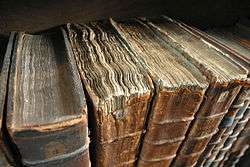Ki Tissa
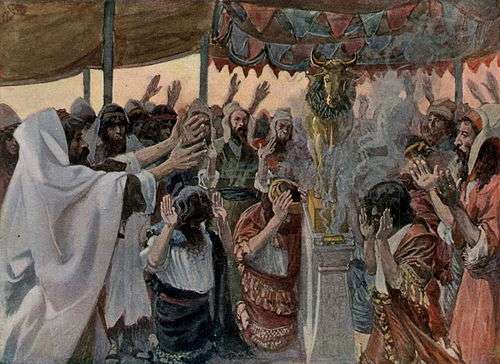
Ki Tisa, Ki Tissa, Ki Thissa, or Ki Sisa (כִּי תִשָּׂא — Hebrew for "when you take," the sixth and seventh words, and first distinctive words in the parashah) is the 21st weekly Torah portion (פָּרָשָׁה, parashah) in the annual Jewish cycle of Torah reading and the ninth in the Book of Exodus. It constitutes Exodus 30:11–34:35. The parashah is the longest of the weekly Torah portions in the book of Exodus (although not the longest in the Torah), and is made up of 7,424 Hebrew letters, 2,002 Hebrew words, and 139 verses, and can occupy about 245 lines in a Torah scroll (סֵפֶר תּוֹרָה, Sefer Torah). (The longest parashah in the Torah is Naso.)[1]
Jews read it on the 21st Sabbath after Simchat Torah, in February or March.[2] Jews also read the first part of the parashah, Exodus 30:11–16, regarding the half-shekel head tax, as the maftir Torah reading on the special Sabbath Shabbat Shekalim (as on March 1, 2014, when Exodus 30:11–16 was read along with parashah Pekudei). Jews also read parts of the parashah addressing the intercession of Moses and God's mercy, Exodus 32:11–14 and 34:1–10, as the Torah readings on the fast days of the Tenth of Tevet, the Fast of Esther, the Seventeenth of Tammuz, and the Fast of Gedaliah, and for the afternoon (Mincha) prayer service on Tisha B'Av. Jews read another part of the parashah, Exodus 34:1–26, which addresses the Three Pilgrim Festivals (Shalosh Regalim), as the initial Torah reading on the third intermediate day (Chol HaMoed) of Passover. And Jews read a larger selection from the same part of the parashah, Exodus 33:12–34:26, as the initial Torah reading on a Sabbath that falls on one of the intermediate days of Passover or Sukkot.
The parashah tells of building the Tabernacle, the incident of the Golden calf, the request of Moses for God to reveal God's attributes, and how Moses became radiant.
Readings
In traditional Sabbath Torah reading, the parashah is divided into seven readings, or עליות, aliyot. In the Masoretic Text of the Tanakh (Hebrew Bible), Parashah Ki Tisa has ten "open portion" (פתוחה, petuchah) divisions (roughly equivalent to paragraphs, often abbreviated with the Hebrew letter פ (peh)). Parashah Ki Tisa has several further subdivisions, called "closed portion" (סתומה, setumah) divisions (abbreviated with the Hebrew letter ס (samekh)) within the open portion (פתוחה, petuchah) divisions. The first three open portion (פתוחה, petuchah) divisions divide the long first reading (עליה, aliyah), and the next three open portion (פתוחה, petuchah) divisions divide the long second reading (עליה, aliyah). The seventh open portion (פתוחה, petuchah) corresponds to the short third reading (עליה, aliyah), and the eighth open portion (פתוחה, petuchah) corresponds to the short fourth reading (עליה, aliyah). The ninth open portion (פתוחה, petuchah) spans the fifth and sixth readings (עליות, aliyot). And the tenth open portion (פתוחה, petuchah) begins in the seventh reading (עליה, aliyah). Closed portion (סתומה, setumah) divisions further divide the first and second readings (עליות, aliyot), and conclude the seventh reading (עליה, aliyah).[3]
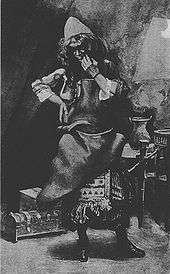
First reading — Exodus 30:11–31:17
In the long first reading (עליה, aliyah), God instructed Moses that when he took a census of the Israelites, each person 20 years old or older, regardless of wealth, should give a half-shekel offering.[4] God told Moses to assign the proceeds to the service of the Tent of Meeting.[5] The first open portion (פתוחה, petuchah) ends here.[6]
In the continuation of the reading, God told Moses to place a copper laver (כִּיּוֹר, kiyor) between the Tent of Meeting and the altar (מִּזְבֵּחַ, mizbeiach), so that Aaron and the priests could wash their hands and feet in water when they entered the Tent of Meeting or approached the altar to burn a sacrifice, so that they would not die.[7] The second open portion (פתוחה, petuchah) ends here.[8]
In the continuation of the reading, God directed Moses to make a sacred anointing oil from choice spices — myrrh, cinnamon, cassia — and olive oil.[9] God told Moses to use it to anoint the Tent of Meeting, the furnishings of the Tabernacle, and the priests.[10] God told Moses to warn the Israelites not to copy the sacred anointing oil's recipe for lay purposes, at pain of exile.[11] A closed portion (סתומה, setumah) ends here.[12]

In the continuation of the reading, God directed Moses make sacred incense from herbs — stacte, onycha, galbanum, and frankincense — to burn in the Tent of Meeting.[13] As with the anointing oil, God warned against making incense from the same recipe for lay purposes.[14] Another closed portion (סתומה, setumah) ends here with the end of chapter 30.[15]
As the reading continues in chapter 31, God informed Moses that God had endowed Bezalel of the Tribe of Judah with divine skill in every kind of craft.[16] God assigned to him Oholiab of the Tribe of Dan and granted skill to all who are skillful, that they might make the furnishings of the Tabernacle, the priests' vestments, the anointing oil, and the incense.[17] The third open portion (פתוחה, petuchah) ends here.[18]
In the continuation of the reading, God told Moses to admonish the Israelites nevertheless to keep the Sabbath, on pain of death.[19] The first reading (עליה, aliyah) and a closed portion (סתומה, setumah) end here.[20]
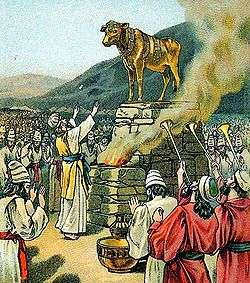
Second reading — Exodus 31:18–33:11
In the long second reading (עליה, aliyah), God gave Moses two stone tablets inscribed by the finger of God.[21] Meanwhile, the people became impatient for the return of Moses, and implored Aaron to make them a god.[22] Aaron told them to bring him their gold earrings, and he cast them in a mold and made a molten golden calf.[23] They exclaimed, "This is your god, O Israel, who brought you out of the land of Egypt!"[24] Aaron built an altar before the calf, and announced a festival of the Lord.[25] The people offered sacrifices, ate, drank, and danced.[26] The fourth open portion (פתוחה, petuchah) ends here.[27]
In the continuation of the reading, God told Moses what the people had done, saying "let Me be, that My anger may blaze forth against them and that I may destroy them, and make of you a great nation."[28] But Moses implored God not to do so, lest the Egyptians say that God delivered the people only to kill them off in the mountains.[29] Moses called on God to remember Abraham, Isaac, and Jacob, and God's oath to make their offspring as numerous as the stars, and God renounced the planned punishment.[30] The fifth open portion (פתוחה, petuchah) ends here.[31]
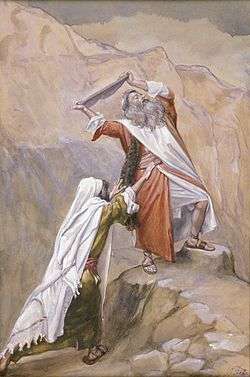
In the continuation of the reading, Moses descended the mountain bearing the two Tablets.[32] Joshua told Moses, "There is a cry of war in the camp," but Moses answered, "It is the sound of song that I hear!"[33] When Moses saw the calf and the dancing, he became enraged and shattered the Tablets at the foot of the mountain.[34] He burned the calf, ground it to powder, strewed it upon the water, and made the Israelites drink it.[35] When Moses asked Aaron how he committed such a great sin, Aaron replied that the people asked him to make a god, so he hurled their gold into the fire, "and out came this calf!"[36] Seeing that Aaron had let the people get out of control, Moses stood in the camp gate and called, "Whoever is for the Lord, come here!"[37] All the Levites rallied to Moses, and at his instruction killed 3,000 people, including brother, neighbor, and kin.[38] Moses went back to God and asked for God either to forgive the Israelites or kill Moses too, but God insisted on punishing only the sinners, which God did by means of a plague.[39] A closed portion (סתומה, setumah) ends here with the end of chapter 32.[40]
As the reading continues in chapter 33, God dispatched Moses and the people to the Promised Land, but God decided not to go in their midst, for fear of destroying them on the way.[41] Upon hearing this, the Israelites went into mourning.[42] Now Moses would pitch the Tent of Meeting outside the camp, and Moses would enter to speak to God, face to face.[43] The second reading (עליה, aliyah) and the sixth open portion (פתוחה, petuchah) end here.[44]
.jpg)
Third reading — Exodus 33:12–16
In the short third reading (עליה, aliyah), Moses asked God whom God would send with Moses to lead the people.[45] Moses further asked God to let him know God's ways, that Moses might know God and continue in God's favor.[46] And God agreed to lead the Israelites.[47] Moses asked God not to make the Israelites move unless God were to go in the lead.[48] The third reading (עליה, aliyah) and the seventh open portion (פתוחה, petuchah) end here.[49]
Fourth reading — Exodus 33:17–23
In the short fourth reading (עליה, aliyah), God agreed to lead them.[50] Moses asked God to let him behold God's Presence.[51] God agreed to make all God's goodness pass before Moses and to proclaim God's name and nature, but God explained that no human could see God's face and live.[52] God instructed Moses to station himself on a rock, where God would cover him with God's hand until God had passed, at which point Moses could see God's back.[53] The fourth reading (עליה, aliyah) and the eighth open portion (פתוחה, petuchah) end here with the end of chapter 33.[54]
.jpg)
Fifth reading — Exodus 34:1–9
In the fifth reading (עליה, aliyah), in chapter 34, God directed Moses to carve two stone tablets like the ones that Moses shattered, so that God might inscribe upon them the words that were on the first Tablets, and Moses did so.[55] God came down in a cloud and proclaimed: "The Lord! The Lord! A God compassionate and gracious, slow to anger, abounding in kindness and faithfulness, extending kindness to the thousandth generation, forgiving iniquity, transgression, and sin; yet He does not remit all punishment, but visits the iniquity of parents upon children and children's children, upon the third and fourth generations."[56] Moses bowed low and asked God to accompany the people in their midst, to pardon the people's iniquity, and to take them for God's own.[57] The fifth reading (עליה, aliyah) ends here.[58]
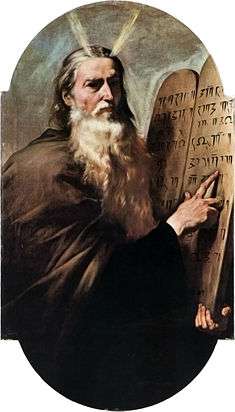
Sixth reading — Exodus 34:10–26
In the sixth reading (עליה, aliyah), God replied by making a covenant to work unprecedented wonders and to drive out the peoples of the Promised Land.[59] God warned Moses against making a covenant with them, lest they become a snare and induce the Israelites' children to lust after their gods.[60] God commanded that the Israelites not make molten gods, that they consecrate or redeem every first-born, that they observe the Sabbath, that they observe the Three Pilgrim Festivals, that they not offer sacrifices with anything leavened, that they not leave the Passover lamb lying until morning, that they bring choice first fruits to the house of the Lord, and that they not boil a kid in its mother's milk.[61] The sixth reading (עליה, aliyah) and the ninth open portion (פתוחה, petuchah) end here.[62]
Seventh reading — Exodus 34:27–35
In the seventh reading (עליה, aliyah), Moses stayed with God 40 days and 40 nights, ate no bread, drank no water, and wrote down on the Tablets the terms of the covenant.[63] As Moses came down from the mountain bearing the two Tablets, the skin of his face was radiant, and the Israelites shrank from him.[64] Moses called them near and instructed them concerning all that God had commanded.[65]
In the maftir (מפטיר) reading of Exodus 34:33–35 that concludes the parashah,[66] when Moses finished speaking, he put a veil over his face.[67] Whenever Moses spoke with God, Moses would take his veil off.[68] And when he came out, he would tell the Israelites what he had been commanded, and then Moses would then put the veil back over his face again.[69] The parashah and the final closed portion (סתומה, setumah) end here with the end of chapter 34.[70]
Readings according to the triennial cycle
Jews who read the Torah according to the triennial cycle of Torah reading read the parashah according to the following schedule:[71]
| Year 1 | Year 2 | Year 3 | |
|---|---|---|---|
| 2013–2014, 2016–2017, 2019–2020 . . . | 2014–2015, 2017–2018, 2020–2021 . . . | 2015–2016, 2018–2019, 2021–2022 . . . | |
| Reading | 30:11–31:17 | 31:18–33:11 | 33:12–34:35 |
| 1 | 30:11–13 | 31:18–32:6 | 33:12–16 |
| 2 | 30:14–16 | 32:7–11 | 33:17–23 |
| 3 | 30:17–21 | 32:12–14 | 34:1–9 |
| 4 | 30:22–33 | 32:15–24 | 34:10–17 |
| 5 | 30:34–38 | 32:25–29 | 34:18–21 |
| 6 | 31:1–11 | 32:30–33:6 | 34:22–26 |
| 7 | 31:12–17 | 33:7–11 | 34:27–35 |
| Maftir | 31:15–17 | 33:9–11 | 34:33–35 |
In inner-Biblical interpretation
The parashah has parallels or is discussed in these Biblical sources:[72]
Exodus chapters 25–39
This is the pattern of instruction and construction of the Tabernacle and its furnishings:

| Item | Instruction | Construction | ||
|---|---|---|---|---|
| Order | Verses | Order | Verses | |
| Contributions | 1 | Exodus 25:1–9 | 2 | Exodus 35:4–29 |
| Ark | 2 | Exodus 25:10–22 | 5 | Exodus 37:1–9 |
| Table | 3 | Exodus 25:23–30 | 6 | Exodus 37:10–16 |
| Menorah | 4 | Exodus 25:31–40 | 7 | Exodus 37:17–24 |
| Tabernacle | 5 | Exodus 26:1–37 | 4 | Exodus 36:8–38 |
| Altar of Sacrifice | 6 | Exodus 27:1–8 | 11 | Exodus 38:1–7 |
| Tabernacle Court | 7 | Exodus 27:9–19 | 13 | Exodus 38:9–20 |
| Lamp | 8 | Exodus 27:20–21 | 16 | Numbers 8:1–4 |
| Priestly Garments | 9 | Exodus 28:1–43 | 14 | Exodus 39:1–31 |
| Ordination Ritual | 10 | Exodus 29:1–46 | 15 | Leviticus 8:1–9:24 |
| Altar of Insense | 11 | Exodus 30:1–10 | 8 | Exodus 37:25–28 |
| Laver | 12 | Exodus 30:17–21 | 12 | Exodus 38:8 |
| Anointing Oil | 13 | Exodus 30:22–33 | 9 | Exodus 37:29 |
| Incense | 14 | Exodus 30:34–38 | 10 | Exodus 37:29 |
| Craftspeople | 15 | Exodus 31:1–11 | 3 | Exodus 35:30–36:7 |
| The Sabbath | 16 | Exodus 31:12–17 | 1 | Exodus 35:1–3 |
The Priestly story of the Tabernacle in Exodus 30–31 echoes the Priestly story of creation in Genesis 1:1–2:3.[73] As the creation story unfolds in seven days,[74] the instructions about the Tabernacle unfold in seven speeches.[75] In both creation and Tabernacle accounts, the text notes the completion of the task.[76] In both creation and Tabernacle, the work done is seen to be good.[77] In both creation and Tabernacle, when the work is finished, God takes an action in acknowledgement.[78] In both creation and Tabernacle, when the work is finished, a blessing is invoked.[79] And in both creation and Tabernacle, God declares something "holy."[80]
Martin Buber and others noted that the language used to describe the building of the Tabernacle parallels that used in the story of creation.[81] Jeffrey Tigay noted[82] that the lampstand held seven candles,[83] Aaron wore seven sacral vestments,[84] the account of the building of the Tabernacle alludes to the creation account,[85] and the Tabernacle was completed on New Year’s day.[86] And Carol Meyers noted that Exodus 25:1–9 and 35:4–29 list seven kinds of substances — metals, yarn, skins, wood, oil, spices, and gemstones — signifying the totality of supplies.[87]
.jpg)
Exodus chapter 31
2 Chronicles 1:5–6 reports that the bronze altar, which Exodus 38:1–2 reports Bezalel made, still stood before the Tabernacle in Solomon's time, and Solomon sacrificed a thousand burnt offerings on it.

Exodus chapter 32
The report of Exodus 32:1 that "the people assembled" (וַיִּקָּהֵל הָעָם, vayikahel ha'am) is echoed in Exodus 35:1, which opens, "And Moses assembled" (וַיַּקְהֵל מֹשֶׁה, vayakhel Mosheh).
1 Kings 12:25–33 reports a parallel story of golden calves. King Jeroboam of the northern Kingdom of Israel made two calves of gold out of a desire to prevent the kingdom from returning to allegiance to the house of David and the southern Kingdom of Judah.[88] In Exodus 32:4, the people said of the Golden Calf, "This is your god, O Israel, that brought you up out of the land of Egypt." Similalrly, in 1 Kings 12:28, Jeroboam told the people of his golden calves, "You have gone up long enough to Jerusalem; behold your gods, O Israel, that brought you up out of the land of Egypt." Jeroboam set up one of the calves in Bethel, and the other in Dan, and the people went to worship before the calf in Dan.[89] Jeroboam made houses of high places, and made priests from people who were not Levites.[90] He ordained a feast like Sukkot on the fifteenth day of the eighth month (a month after the real Sukkot), and he went up to the altar at Bethel to sacrifice to the golden calves that he had made, and he installed his priests there.[91]
In Exodus 32:13 and Deuteronomy 9:27, Moses called on God to "remember" God's covenant with Abraham, Isaac, and Jacob to deliver the Israelites from God's wrath after the incident of the Golden Calf. Similarly, God remembered Noah to deliver him from the flood in Genesis 8:1; God promised to remember God's covenant not to destroy the Earth again by flood in Genesis 9:15–16; God remembered Abraham to deliver Lot from the destruction of Sodom and Gomorrah in Genesis 19:29; God remembered Rachel to deliver her from childlessness in Genesis 30:22; God remembered God's covenant with Abraham, Isaac, and Jacob to deliver the Israelites from Egyptian bondage in Exodus 2:24 and 6:5–6; God promised to "remember" God's covenant with Jacob, Isaac, and Abraham to deliver the Israelites and the Land of Israel in Leviticus 26:42–45; the Israelites were to blow upon their trumpets to be remembered and delivered from their enemies in Numbers 10:9; Samson called on God to deliver him from the Philistines in Judges 16:28; Hannah prayed for God to remember her and deliver her from childlessness in 1 Samuel 1:11 and God remembered Hannah's prayer to deliver her from childlessness in 1 Samuel 1:19; Hezekiah called on God to remember Hezekiah's faithfulness to deliver him from sickness in 2 Kings 20:3 and Isaiah 38:3; Jeremiah called on God to remember God's covenant with the Israelites to not condemn them in Jeremiah 14:21; Jeremiah called on God to remember him and think of him, and avenge him of his persecutors in Jeremiah 15:15; God promises to remember God's covenant with the Israelites and establish an everlasting covenant in Ezekiel 16:60; God remembers the cry of the humble in Zion to avenge them in Psalm 9:13; David called upon God to remember God's compassion and mercy in Psalm 25:6; Asaph called on God to remember God's congregation to deliver them from their enemies in Psalm 74:2; God remembered that the Israelites were only human in Psalm 78:39; Ethan the Ezrahite called on God to remember how short Ethan's life was in Psalm 89:48; God remembers that humans are but dust in Psalm 103:14; God remembers God's covenant with Abraham, Isaac, and Jacob in Psalm 105:8–10; God remembers God's word to Abraham to deliver the Israelites to the Land of Israel in Psalm 105:42–44; the Psalmist calls on God to remember him to favor God's people, to think of him at God's salvation, that he might behold the prosperity of God's people in Psalm 106:4–5; God remembered God's covenant and repented according to God's mercy to deliver the Israelites in the wake of their rebellion and iniquity in Psalm 106:4–5; the Psalmist calls on God to remember God's word to God's servant to give him hope in Psalm 119:49; God remembered us in our low estate to deliver us from our adversaries in Psalm 136:23–24; Job called on God to remember him to deliver him from God's wrath in Job 14:13; Nehemiah prayed to God to remember God's promise to Moses to deliver the Israelites from exile in Nehemiah 1:8; and Nehemiah prayed to God to remember him to deliver him for good in Nehemiah 13:14–31.
Exodus chapter 34
Passover
Exodus 34:18 refers to the Festival of Passover, calling it "the Feast of Unleavened Bread." In the Hebrew Bible, Passover is called:
- "Passover" (Pesach, פֶּסַח);[92]
- "The Feast of Unleavened Bread" (Chag haMatzot, חַג הַמַּצּוֹת);[93] and
- "A holy convocation" or "a solemn assembly" (mikrah kodesh, מִקְרָא-קֹדֶשׁ).[94]
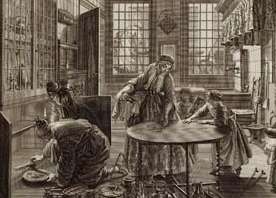
Some explain the double nomenclature of "Passover" and "Feast of Unleavened Bread" as referring to two separate feasts that the Israelites combined sometime between the Exodus and when the Biblical text became settled.[95] Exodus 34:18–20 and Deuteronomy 15:19–16:8 indicate that the dedication of the firstborn also became associated with the festival.
Some believe that the "Feast of Unleavened Bread" was an agricultural festival at which the Israelites celebrated the beginning of the grain harvest. Moses may have had this festival in mind when in Exodus 5:1 and 10:9 he petitioned Pharaoh to let the Israelites go to celebrate a feast in the wilderness.[96]
"Passover," on the other hand, was associated with a thanksgiving sacrifice of a lamb, also called "the Passover," "the Passover lamb," or "the Passover offering."[97]

Exodus 12:5–6, Leviticus 23:5, and Numbers 9:3 and 5, and 28:16 direct "Passover" to take place on the evening of the fourteenth of Aviv (Nisan in the Hebrew calendar after the Babylonian captivity). Joshua 5:10, Ezekiel 45:21, Ezra 6:19, and 2 Chronicles 35:1 confirm that practice. Exodus 12:18–19, 23:15, and 34:18, Leviticus 23:6, and Ezekiel 45:21 direct the "Feast of Unleavened Bread" to take place over seven days and Leviticus 23:6 and Ezekiel 45:21 direct that it begin on the fifteenth of the month. Some believe that the propinquity of the dates of the two festivals led to their confusion and merger.[96]
Exodus 12:23 and 27 link the word "Passover" (Pesach, פֶּסַח) to God's act to "pass over" (pasach, פָסַח) the Israelites' houses in the plague of the firstborn. In the Torah, the consolidated Passover and Feast of Unleavened Bread thus commemorate the Israelites' liberation from Egypt.[98]
The Hebrew Bible frequently notes the Israelites' observance of Passover at turning points in their history. Numbers 9:1–5 reports God's direction to the Israelites to observe Passover in the wilderness of Sinai on the anniversary of their liberation from Egypt. Joshua 5:10–11 reports that upon entering the Promised Land, the Israelites kept the Passover on the plains of Jericho and ate unleavened cakes and parched corn, produce of the land, the next day. 2 Kings 23:21–23 reports that King Josiah commanded the Israelites to keep the Passover in Jerusalem as part of Josiah's reforms, but also notes that the Israelites had not kept such a Passover from the days of the Biblical judges nor in all the days of the kings of Israel or the kings of Judah, calling into question the observance of even Kings David and Solomon. The more reverent 2 Chronicles 8:12–13, however, reports that Solomon offered sacrifices on the festivals, including the Feast of Unleavened Bread. And 2 Chronicles 30:1–27 reports King Hezekiah's observance of a second Passover anew, as sufficient numbers of neither the priests nor the people were prepared to do so before then. And Ezra 6:19–22 reports that the Israelites returned from the Babylonian captivity observed Passover, ate the Passover lamb, and kept the Feast of Unleavened Bread seven days with joy.
Shavuot
Exodus 34:22 refers to the Festival of Shavuot. In the Hebrew Bible, Shavuot is called:
- The Feast of Weeks (חַג שָׁבֻעֹת, Chag Shavuot);[99]
- The Day of the First-fruits (יוֹם הַבִּכּוּרִים, Yom haBikurim);[100]
- The Feast of Harvest (חַג הַקָּצִיר, Chag haKatzir);[101] and
- A holy convocation (מִקְרָא-קֹדֶשׁ, mikrah kodesh).[102]
Exodus 34:22 associates Shavuot with the first-fruits (בִּכּוּרֵי, bikurei) of the wheat harvest.[103] In turn, Deuteronomy 26:1–11 set out the ceremony for the bringing of the first fruits.
To arrive at the correct date, Leviticus 23:15 instructs counting seven weeks from the day after the day of rest of Passover, the day that they brought the sheaf of barley for waving. Similarly, Deuteronomy 16:9 directs counting seven weeks from when they first put the sickle to the standing barley.
Leviticus 23:16–19 sets out a course of offerings for the fiftieth day, including a meal-offering of two loaves made from fine flour from the first-fruits of the harvest; burnt-offerings of seven lambs, one bullock, and two rams; a sin-offering of a goat; and a peace-offering of two lambs. Similarly, Numbers 28:26–30 sets out a course of offerings including a meal-offering; burnt-offerings of two bullocks, one ram, and seven lambs; and one goat to make atonement. Deuteronomy 16:10 directs a freewill-offering in relation to God's blessing.
Leviticus 23:21 and Numbers 28:26 ordain a holy convocation in which the Israelites were not to work.
2 Chronicles 8:13 reports that Solomon offered burnt-offerings on the Feast of Weeks.
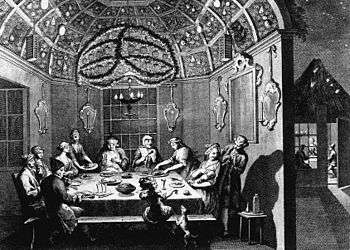
Sukkot
And Exodus 34:22 refers to the Festival of Sukkot, calling it "the Feast of Ingathering." In the Hebrew Bible, Sukkot is called:
- "The Feast of Tabernacles (or Booths)";[104]
- "The Feast of Ingathering";[105]
- "The Feast" or "the festival";[106]
- "The Feast of the Lord";[107]
- "The festival of the seventh month";[108] and
- "A holy convocation" or "a sacred occasion."[109]
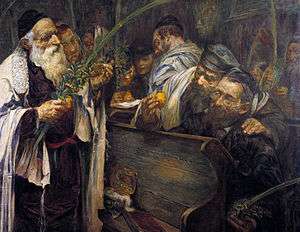
Sukkot's agricultural origin is evident from the name "The Feast of Ingathering," from the ceremonies accompanying it, and from the season and occasion of its celebration: "At the end of the year when you gather in your labors out of the field";[101] "after you have gathered in from your threshing-floor and from your winepress."[110] It was a thanksgiving for the fruit harvest.[111] And in what may explain the festival's name, Isaiah reports that grape harvesters kept booths in their vineyards.[112] Coming as it did at the completion of the harvest, Sukkot was regarded as a general thanksgiving for the bounty of nature in the year that had passed.
Sukkot became one of the most important feasts in Judaism, as indicated by its designation as "the Feast of the Lord"[107] or simply "the Feast."[106] Perhaps because of its wide attendance, Sukkot became the appropriate time for important state ceremonies. Moses instructed the children of Israel to gather for a reading of the Law during Sukkot every seventh year.[113] King Solomon dedicated the Temple in Jerusalem on Sukkot.[114] And Sukkot was the first sacred occasion observed after the resumption of sacrifices in Jerusalem after the Babylonian captivity.[115]

In the time of Nehemiah, after the Babylonian captivity, the Israelites celebrated Sukkot by making and dwelling in booths, a practice of which Nehemiah reports: "the Israelites had not done so from the days of Joshua."[116] In a practice related to that of the Four Species, Nehemiah also reports that the Israelites found in the Law the commandment that they "go out to the mountains and bring leafy branches of olive trees, pine trees, myrtles, palms and [other] leafy trees to make booths."[117] In Leviticus 23:40, God told Moses to command the people: "On the first day you shall take the product of hadar trees, branches of palm trees, boughs of leafy trees, and willows of the brook," and "You shall live in booths seven days; all citizens in Israel shall live in booths, in order that future generations may know that I made the Israelite people live in booths when I brought them out of the land of Egypt."[118] The book of Numbers, however, indicates that while in the wilderness, the Israelites dwelt in tents.[119] Some secular scholars consider Leviticus 23:39–43 (the commandments regarding booths and the four species) to be an insertion by a later redactor.[120]
King Jeroboam of the northern Kingdom of Israel, whom 1 Kings 13:33 describes as practicing "his evil way," celebrated a festival on the fifteenth day of the eighth month, one month after Sukkot, "in imitation of the festival in Judah."[121] "While Jeroboam was standing on the altar to present the offering, the man of God, at the command of the Lord, cried out against the altar" in disapproval.[122]
According to the prophet Zechariah, in the messianic era, Sukkot will become a universal festival, and all nations will make pilgrimages annually to Jerusalem to celebrate the feast there.[123]
Milk
In three separate places — Exodus 23:19 and 34:26 and Deuteronomy 14:21 — the Torah prohibits boiling a kid in its mother's milk.

In early nonrabbinic interpretation
The parashah is discussed in these early nonrabbinic sources:[124]
Exodus chapter 31
Josephus taught that when the Israelites brought together the materials with great diligence, Moses set architects over the works by the command of God. And these were the very same people that the people themselves would have chosen, had the election been allowed to them: Bezalel, the son of Uri, of the tribe of Judah, the grandson of Miriam, the sister of Moses, and Oholiab, file son of Ahisamach, of the tribe of Dan.[125]
In classical rabbinic interpretation
The parashah is discussed in these rabbinic sources from the era of the Mishnah and the Talmud:[126]
Exodus chapter 30
The Rabbis taught in a Baraita that upon entering a barn to measure the new grain one should recite the blessing, "May it be Your will O Lord, our God, that You may send blessing upon the work of our hands." Once one has begun to measure, one should say, "Blessed be the One who sends blessing into this heap." If, however, one first measured the grain and then recited the blessing, then prayer is in vain, because blessing is not to be found in anything that has been already weighed or measured or numbered, but only in a thing hidden from sight.[127]
Rabbi Abbahu taught that Moses asked God how Israel would be exalted, and God replied in the words of Exodus 30:12 (about collecting the half-shekel tax), "When you raise them up," teaching that collecting contributions from the people elevates them.[128]
Rabbi Eleazar taught that God told David that David called God an inciter, but God would make David stumble over a thing that even school-children knew, namely, that which Exodus 30:12 says, "When you take the sum of the children of Israel according to their number, then shall they give every man a ransom for his soul into the Lord . . . that there be no plague among them." Forthwith, as 1 Chronicles 21:1 reports, "Satan stood up against Israel," and as 2 Samuel 24:1 reports, "He stirred up David against them saying, ‘Go, number Israel.'" And when David did number them, he took no ransom from them, and as 2 Samuel 24:15 reports, "So the Lord sent a pestilence upon Israel from the morning even to the time appointed." The Gemara asked what 2 Samuel 24:15 meant by "the time appointed." Samuel the elder, the son-in-law of Rabbi Hanina, answered in the name of Rabbi Hanina: From the time of slaughtering the continual offering (at dawn) until the time of sprinkling the blood. Rabbi Johanan said it meant at midday. Reading the continuation of 2 Samuel 24:16, "And He said to the Angel that destroyed the people, ‘It is enough (רַב, rav),'" Rabbi Eleazar taught that God told the Angel to take a great man (רַב, rav) from among them, through whose death many sins could be expiated. So Abishai son of Zeruiah then died, and he was individually equal in worth to the greater part of the Sanhedrin. Reading 1 Chronicles 21:15, "And as he was about to destroy, the Lord beheld, and He repented," the Gemara ask what God beheld. Rav said God beheld Jacob, as Genesis 32:3 reports, "And Jacob said when he beheld them." Samuel said that God beheld the ashes of the ram of Isaac, as Genesis 22:8 says, "God will see for Himself the lamb." Rabbi Isaac Nappaha taught that God saw the atonement money that Exodus 30:16 reports God required Moses to collect. For in Exodus 30:16, God said, "And you shall take the atonement money from the children of Israel, and shalt appoint it for the service of the tent of meeting, that it may be a memorial for the children of Israel before the Lord, to make atonement for your souls.'" (Thus God said that at some future time, the money would provide atonement.) Alternatively, Rabbi Johanan taught that God saw the Temple. For Genesis 22:14 explained the meaning of the name that Abraham gave to the mountain where Abraham nearly sacrificed Isaac to be, "In the mount where the Lord is seen." (Solomon later built the Temple on that mountain, and God saw the merit of the sacrifices there.) Rabbi Jacob bar Iddi and Rabbi Samuel bar Nahmani differed on the matter. One said that God saw the atonement money that Exodus 30:16 reports God required Moses to collect from the Israelites, while the other said that God saw the Temple. The Gemara concluded that the more likely view was that God saw the Temple, as Genesis 22:14 can be read to say, "As it will be said on that day, ‘in the mount where the Lord is seen.'"[129]
The first four chapters of Tractate Shekalim in the Mishnah, Tosefta, Jerusalem Talmud, and Babylonian Talmud interpreted the law of the half-shekel head tax commanded by Exodus 30:13–16.[130]
Reading Exodus 30:13, “This they shall give . . . half a shekel for an offering to the Lord,” to indicate that God pointed with God’s finger, Rabbi Ishmael said that each of the five fingers of God’s right hand appertain to the mystery of Redemption. Rabbi Ishmael said that God showed the little finger of the hand to Noah, pointing out how to make the Ark, as in Genesis 6:15, God says, “And this is how you shall make it.” With the second finger, next to the little one, God smote the Egyptians with the ten plagues, as Exodus 8:15 (8:19 in the KJV) says, “The magicians said to Pharaoh, ‘This is the finger of God.’” With the middle finger, God wrote the Tablets of the Law, as Exodus 31:18 says, “And He gave to Moses, when He had made an end of communing with him . . . tables of stone, written with the finger of God.” With the index finger, God showed Moses what the children of Israel should give for the redemption of their souls, as Exodus 30:13 says, “This they shall give . . . half a shekel for an offering to the Lord.” With the thumb and all the hand, God will in the future smite God’s enemies (who Rabbi Ishmael identified as the children of Esau and Ishmael), as Micah 5:9 says, “Let your hand be lifted up above your adversaries, and let all your enemies be cut off.”[131]
.jpg)
The Mishnah taught that any sacrifice performed by a priest who had not washed his hands and feet at the laver as required by Exodus 30:18–21 was invalid.[132]
Rabbi Jose the son of Rabbi Hanina taught that a priest was not permitted to wash in a laver that did not contain enough water to wash four priests, for Exodus 40:31 says, "That Moses and Aaron and his sons might wash their hands and their feet thereat." ("His sons" implies at least two priests, and adding Moses and Aaron makes four.)[133]
The Mishnah reported that the High Priest Ben Katin made 12 spigots for the laver, where there had been two before. Ben Katin also made a machine for the laver, so that its water would not become unfit by remaining overnight.[134]
The Mishnah counted compounding anointing oil in the formula prescribed in Exodus 30:23–33 and using such sacred anointing oil in a way prohibited by Exodus 30:32 as 2 among 36 transgressions in the Torah punishable with excision (כרת, karet). The Mishnah taught that for these transgressions, one was liable to excision if one violated the commandment willfully. If one violated the commandment in error, one was liable to a sin offering. If there was a doubt whether one had violated the commandment, one was liable to a suspensive guilt offering, except, taught Rabbi Meir, in the case of one who defiled the Temple or its consecrated things, in which case one was liable to a sliding-scale sacrifice (according to the means of the transgressor, as provided in Leviticus 5:6–11).[135]
Rabbi Judah taught that many miracles attended the anointing oil that Moses made in the wilderness. There were originally only 12 logs (about a gallon) of the oil. Much of it must have been absorbed in the mixing pot, much must have been absorbed in the roots of the spices used, and much of it must have evaporated during cooking. Yet it was used to anoint the Tabernacle and its vessels, Aaron and his sons throughout the seven days of the consecration, and subsequent High Priests and kings. The Gemara deduced from Exodus 30:31, "This (זֶה, zeh) shall be a holy anointing oil unto Me throughout your generations," that 12 logs existed. The Gemara calculated the numerical value of the Hebrew letters in the word זֶה, zeh ("this") to be 12 (employing Gematria, where ז equals 7 and ה equals 5), indicating that 12 logs of the oil were preserved throughout time.[136]
Exodus chapter 31
Rabbi Johanan taught that God proclaims three things for God's Self: famine, plenty, and a good leader. 2 Kings 8:1 shows that God proclaims famine, when it says: "The Lord has called for a famine." Ezekiel 36:29 shows that God proclaims plenty, when it says: "I will call for the corn and will increase it." And Exodus 31:1–2 shows that God proclaims a good leader, when it says: "And the Lord spoke to Moses, saying, ‘See I have called by name Bezalel, the son of Uri.'" Rabbi Isaac taught that we cannot appoint a leader over a community without first consulting the people, as Exodus 35:30 says: "And Moses said to the children of Israel: ‘See, the Lord has called by name Bezalel, the son of Uri.'" Rabbi Isaac taught that God asked Moses whether Moses considered Bezalel suitable. Moses replied that if God thought Bezalel suitable, surely Moses must also. God told Moses that, all the same, Moses should go and consult the people. Moses then asked the Israelites whether they considered Bezalel suitable. They replied that if God and Moses considered Bezalel suitable, then surely they had to, as well. Rabbi Samuel bar Nahmani said in the name of Rabbi Johanan that Bezalel (בְּצַלְאֵל, whose name can be read בְּצֵל אֶל, betzel El, "in the shadow of God") was so called because of his wisdom. When God told Moses (in Exodus 31:7) to tell Bezalel to make a tabernacle, an ark, and vessels, Moses reversed the order and told Bezalel to make an ark, vessels, and a tabernacle. Bezalel replied to Moses that as a rule, one first builds a house and then brings vessels into it, but Moses directed to make an ark, vessels, and a tabernacle. Bezalel asked where he would put the vessels. And Bezalel asked whether God had told Moses to make a tabernacle, an ark, and vessels. Moses replied that perhaps Bezalel had been in the shadow of God (בְּצֵל אֶל, betzel El) and had thus come to know this. Rav Judah taught in the name of Rav that Exodus 35:31 indicated that God endowed Bezalel with the same attribute that God used in creating the universe. Rav Judah said in the name of Rav that Bezalel knew how to combine the letters by which God created the heavens and earth. For Exodus 35:31 says (about Bezalel), "And He has filled him with the spirit of God, in wisdom and in understanding, and in knowledge," and Proverbs 3:19 says (about creation), "The Lord by wisdom founded the earth; by understanding He established the heavens," and Proverbs 3:20 says, "By His knowledge the depths were broken up."[137]
Rabbi Tanhuma taught in the name of Rav Huna that even the things that Bezalel did not hear from Moses he conceived of on his own exactly as they were told to Moses from Sinai. Rabbi Tanhuma said in the name of Rav Huna that one can deduce this from the words of Exodus 38:22, "And Bezalel the son of Uri, the son of Hur, of the tribe of Judah, made all that the Lord commanded Moses." For Exodus 38:22 does not say, "that Moses commanded him," but, "that the Lord commanded Moses."[138]
And the Agadat Shir ha-Shirim taught that Bezalel and Oholiab went up Mount Sinai, where the heavenly Sanctuary was shown to them.[139]
Tractate Shabbat in the Mishnah, Tosefta, Jerusalem Talmud, and Babylonian Talmud interpreted the laws of the Sabbath in Exodus 16:23 and 29; 20:7–10 (20:8–11 in the NJPS); 23:12; 31:13–17; 35:2–3; Leviticus 19:3; 23:3; Numbers 15:32–36; and Deuteronomy 5:11 (5:12 in the NJPS).[140]
Reading the words "everyone who profanes [the Sabbath] shall surely be put to death" in Exodus 31:14 (in which the verb for death is doubled), Samuel deduced that the Torah decreed many deaths for desecrating the Sabbath. The Gemara posited that perhaps Exodus 31:14 refers to willful desecration. The Gemara answered that Exodus 31:14 is not needed to teach that willful transgression of the Sabbath is a capital crime, for Exodus 35:2 says, "Whoever does any work therein shall be put to death." The Gemara concluded that Exodus 31:14 thus must apply to an unwitting offender, and in that context, the words "shall surely be put to death" mean that the inadvertent Sabbath violator will "die" monetarily because of the violator's need to bring costly sacrifices.[141]
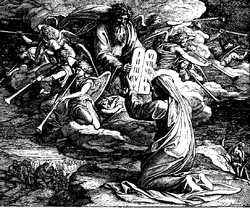
The Mishnah taught that the two Tablets of the Ten Commandments that God gave Moses in Exodus 31:18 were among ten things that God created on the eve of the first Sabbath at twilight.[142]
Rabbi Meir taught that the stone Tablets that God gave Moses in Exodus 31:18 were each 6 handbreadths long, 6 handbreadths wide, and 3 handbreadths thick.[143]
Rabbi Simeon ben Lakish (Resh Lakish) taught that the Torah that God gave Moses was of white fire and its writing of black fire. It was itself fire and it was hewn out of fire and completely formed of fire and given in fire, as Deuteronomy 33:2 says, "At His right hand was a fiery law to them."[144]
Rabbi Samuel bar Nahman taught that when God passed the two Tablets to Moses (as reported in Exodus 31:18), the Tablets conveyed to Moses a lustrous appearance (as reported in Exodus 34:30).[145]
Rabbi Eleazar taught that from the words of Exodus 31:18, "tablets (לֻחֹת, luchot) of stone," one may learn that if one regards one's cheeks (לְחָיָיו, lechayav) as stone that is not easily worn away (constantly speaking words of Torah, regardless of the strain on one's facial muscles), one's learning will be preserved, but otherwise it will not.[146]
Reading “the finger of God” in Exodus 31:18, Rabbi Ishmael said that each of the five fingers of God’s right hand appertain to the mystery of Redemption. Rabbi Ishmael said that God wrote the Tablets of the Law with the middle finger, as Exodus 31:18 says, “And He gave to Moses, when He had made an end of communing with him . . . tables of stone, written with the finger of God.” [147]
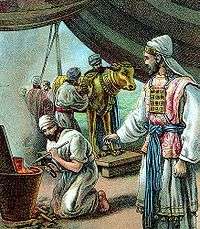
Exodus chapter 32
A Baraita taught that because of God's displeasure with the Israelites, the north wind did not blow on them in any of the 40 years during which they wandered in the wilderness. Rashi attributed God's displeasure to the Golden Calf, although the Tosafot attributed it to the incident of the spies in Numbers 13.[148]
Rabbi Tanhum bar Hanilai taught that Aaron made the Golden Calf in Exodus 32:4 as a compromise with the people's demand in Exodus 32:1 to "make us a god who shall go before us." Rabbi Benjamin bar Japhet, reporting Rabbi Eleazar, interpreted the words of Exodus 32:5, "And when Aaron saw it, he built an altar before it," to mean that Aaron saw (his nephew) Hur lying slain before him and thought that if he did not obey the people, they would kill him as well. (Exodus 24:14 mentions that Moses appointed Hur to share the leadership of the people with Aaron, but after Moses descended from Mount Sinai, Hur's name does not appear again.) Aaron thought that the people would then fulfill the words of Lamentations 2:20, "Shall the Priest and the Prophet be slain in the Sanctuary of God?" and the people would then never find forgiveness. Aaron though it better to let the people worship the Golden Calf, for which they might yet find forgiveness through repentance. And thus Rabbi Tanhum bar Hanilai concluded that it was in reference to Aaron's decision-making in this incident that Psalm 10:3 can be read to mean, "He who praises one who makes a compromise blasphemes God."[149]
The Sages told that Aaron really intended to delay the people until Moses came down, but when Moses saw Aaron beating the Golden Calf into shape with a hammer, Moses thought that Aaron was participating in the sin and was incensed with him. So God told Moses that God knew that Aaron's intentions were good. The Midrash compared it to a prince who became mentally unstable and started digging to undermine his father's house. His tutor told him not to weary himself but to let him dig. When the king saw it, he said that he knew the tutor’s intentions were good, and declared that the tutor would rule over the palace. Similarly, when the Israelites told Aaron in Exodus 32:1, “Make us a god,” Aaron replied in Exodus 32:1, “Break off the golden rings that are in the ears of your wives, of your sons, and of your daughters, and bring them to me.” And Aaron told them that since he was a priest, they should let him make it and sacrifice to it, all with the intention of delaying them until Moses could come down. So God told Aaron that God knew Aaron’s intention, and that only Aaron would have sovereignty over the sacrifices that the Israelites would bring. Hence in Exodus 28:1, God told Moses, “And bring near Aaron your brother, and his sons with him, from among the children of Israel, that they may minister to Me in the priest's office.” The Midrash told that God told this to Moses several months later in the Tabernacle itself when Moses was about to consecrate Aaron to his office. Rabbi Levi compared it to the friend of a king who was a member of the imperial cabinet and a judge. When the king was about to appoint a palace governor, he told his friend that he intended to appoint the friend’s brother. So God made Moses superintendent of the palace, as Numbers 7:7 reports, “My servant Moses is . . . is trusted in all My house,” and God made Moses a judge, as Exodus 18:13 reports, “Moses sat to judge the people.” And when God was about to appoint a High Priest, God notified Moses that it would be his brother Aaron.[150]
A Midrash noted that in the incident of the Golden Calf, in Exodus 32:2, Aaron told them, "Break off the golden rings that are in the ears of your wives," but the women refused to participate, as Exodus 32:3 indicates when it says, "And all the people broke off the golden rings that were in their ears." Similarly, the Midrash noted that Numbers 14:36 says that in the incident of the spies, "the men . . . when they returned, made all the congregation to murmur against him." The Midrash explained that that is why the report of Numbers 27:1–11 about the daughters of Zelophehad follows immediately after the report of Numbers 26:65 about the death of the wilderness generation. The Midrash noted that Numbers 26:65 says, "there was not left a man of them, save Caleb the son of Jephunneh," because the men had been unwilling to enter the Land. But the Midrash taught that Numbers 27:1 says, "then drew near the daughters of Zelophehad," to show that the women still sought an inheritance in the Land. The Midrash taught that in that generation, the women built up fences that the men broke down.[151]
The Pirke De-Rabbi Eliezer expounded on the exchange between God and Moses in Exodus 32:7–14 after the sin of the Golden Calf. The Pirke De-Rabbi Eliezer told that after the incident of the Golden Calf, God told Moses that the Israelites had forgotten God's might and had made an idol. Moses replied to God that while the Israelites had not yet sinned, God had called them "My people," as in Exodus 7:4, God had said, "And I will bring forth My hosts, My people." But Moses noted that once the Israelites had sinned, God told Moses (in Exodus 32:7), "Go, get down, for your people have corrupted themselves." Moses told God that the Israelites were indeed God's people, and God's inheritance, as Deuteronomy 9:29 reports Moses saying, "Yet they are Your people and Your inheritance."[152]

Did the prayer of Moses in Exodus 32:11–14 change God's harsh decree? On this subject, Rabbi Abbahu interpreted David's last words, as reported in 2 Samuel 23:2–3, where David reported that God told him, "Ruler over man shall be the righteous, even he that rules through the fear of God." Rabbi Abbahu read 2 Samuel 23:2–3 to teach that God rules humankind, but the righteous rule God, for God makes a decree, and the righteous may through their prayer annul it.[153]
Rava employed Numbers 30:3 to interpret Exodus 32:11, which says: "And Moses besought (va-yechal) the Lord his God" in connection with the incident of the Golden Calf. Rava noted that Exodus 32:11 uses the term "besought" (va-yechal), while Numbers 30:3 uses the similar term "break" (yachel) in connection with vows. Transferring the use of Numbers 30:3 to Exodus 32:11, Rava reasoned that Exodus 32:11 meant that Moses stood in prayer before God until Moses annulled for God God's vow to destroy Israel, for a master had taught that while people cannot break their vows, others may annul their vows for them.[154] Similarly, Rabbi Berekiah taught in the name of Rabbi Helbo in the name of Rabbi Isaac that Moses absolved God of God's vow. When the Israelites made the Golden Calf, Moses began to persuade God to forgive them, but God explained to Moses that God had already taken an oath in Exodus 22:19 that "he who sacrifices to the gods . . . shall be utterly destroyed," and God could not retract an oath. Moses responded by asking whether God had not granted Moses the power to annul oaths in Numbers 30:3 by saying, "When a man vows a vow to the Lord, or swears an oath to bind his soul with a bond, he shall not break his word," implying that while he himself could not break his word, a scholar could absolve his vow. So Moses wrapped himself in his cloak and adopted the posture of a sage, and God stood before Moses as one asking for the annulment of a vow.[155]
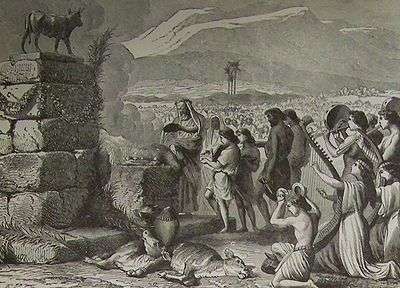
The Gemara deduced from the example of Moses in Exodus 32:11. that one should seek an interceding frame of mind before praying. Rav Huna and Rav Hisda were discussing how long to wait between recitations of the Amidah prayer if one erred in the first reciting and needed to repeat the prayer. One said: long enough for the person praying to fall into a suppliant frame of mind, citing the words "And I supplicated the Lord" in Deuteronomy 3:23. The other said: long enough to fall into an interceding frame of mind, citing the words "And Moses interceded" in Exodus 32:11.[156]
.jpg)
Interpreting Exodus 32:15 on the "tablets that were written on both their sides," Rav Chisda said that the writing of the Tablets was cut completely through the Tablets, so that it could be read from either side. Thus the letters mem and samekh, which each form a complete polygon, left some of the stone Tablets in the middle of those letters standing in the air where they were held stable only by a miracle.[157]
Rabbi Samuel bar Nahman told that when the Israelites exclaimed, "This is your God, O Israel" in Exodus 32:4, Moses was just then descending from Mount Sinai. Joshua told Moses (in Exodus 32:17), "There is a noise of war in the camp." But Moses retorted (in Exodus 32:18), "It is not the voice of them that shout for mastery; neither is it the voice of them that cry for being overcome, but the noise of them that sing do I hear." Rabbi Samuel bar Nahman interpreted the words, "but the noise of them that sing do I hear," to mean that Moses heard the noise of reproach and blasphemy. The men of the Great Assembly noted that Nehemiah 9:18 reports, "They had made a molten calf, and said: ‘This is your God that brought you up out of Egypt.'" That would be sufficient provocation, but Nehemiah 9:18 continues, "And wrought great provocations." The men of the Great Assembly thus concluded that Nehemiah 9:18 demonstrates that in addition to making the Golden Calf, on that occasion the Israelites also uttered reproaches and blasphemy.[158]
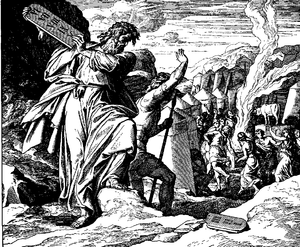
A Midrash explained why Moses broke the stone Tablets. When the Israelites committed the sin of the Golden Calf, God sat in judgment to condemn them, as Deuteronomy 9:14 says, "Let Me alone, that I may destroy them," but God had not yet condemned them. So Moses took the Tablets from God to appease God's wrath. The Midrash compared the act of Moses to that of a king's marriage-broker. The king sent the broker to secure a wife for the king, but while the broker was on the road, the woman corrupted herself with another man. The broker (who was entirely innocent) took the marriage document that the king had given the broker to seal the marriage and tore it, reasoning that it would be better for the woman to be judged as an unmarried woman than as a wife.[159]

Rabbi Eleazar taught that one could learn from the words of Exodus 32:16, "carved on the tablets," that if the first two Tablets had not been broken, the Torah would have remained carved forever, and the Torah would never have been forgotten in Israel. Rav Aha bar Jacob said that no nation or tongue would have had any power over Israel, as one can read the word "carved" (חָרוּת, charut) in Exodus 32:16 as "freedom" (חֵרוּת, cheirut). (Thus, for the sake of the original two Tablets, Israel would have remained forever free.)[146]
A Baraita taught that when Moses broke the Tablets in Exodus 32:19, it was one of three actions that Moses took based on his own understanding with which God then agreed. The Gemara explained that Moses reasoned that if the Passover lamb, which was just one of the 613 commandments, was prohibited by Exodus 12:43 to aliens, then certainly the whole Torah should be prohibited to the Israelites, who had acted as apostates with the Golden Calf. The Gemara deduced God's approval from God's mention of Moses' breaking the Tablets in Exodus 34:1. Resh Lakish interpreted this to mean that God gave Moses strength because he broke the Tablets.[160]
A Midrash taught that in recompense for Moses having grown angry and breaking the first set of Tablets in Exodus 32:19, God imposed on Moses the job of carving the second set of two Tablets in Deuteronomy 10:1.[161]
The Rabbis taught that Exodus 32:19 and Deuteronomy 10:1 bear out Ecclesiastes 3:5, “A time to cast away stones, and a time to gather stones together.” The Rabbis taught that Ecclesiastes 3:5 refers to Moses. For there was a time for Moses to cast away the Tablets in Exodus 32:19, and a time for him to restore them to Israel in Deuteronomy 10:1.[162]
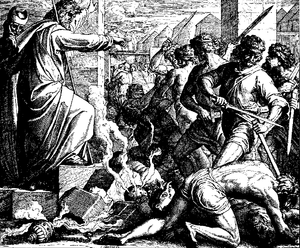
Reading the report of Exodus 32:20 that Moses "took the calf . . . ground it to powder, and sprinkled it on the water, and made the children of Israel drink it," the Sages interpreted that Moses meant to test the Israelites much as the procedure of Numbers 5:11–31 tested a wife accused of adultery (sotah).[163]
The Rabbis taught that through the word "this," Aaron became degraded, as it is said in Exodus 32:22–24, "And Aaron said: ‘. . . I cast it into the fire, and there came out this calf,'" and through the word "this," Aaron was also elevated, as it is said in Leviticus 6:13, "This is the offering of Aaron and of his sons, which they shall offer to the Lord on the day when he is anointed" to become High Priest.[164]
A Midrash noted that Israel sinned with fire in making the Golden Calf, as Exodus 32:24 says, "And I cast it into the fire, and there came out this calf." And then Bezalel came and healed the wound (and the construction of the Tabernacle made atonement for the sins of the people in making the Golden Calf). The Midrash likened it to the words of Isaiah 54:16, "Behold, I have created the smith who blows the fire of coals." The Midrash taught that Bezalel was the smith whom God had created to address the fire. And the Midrash likened it to the case of a doctor's disciple who applied a plaster to a wound and healed it. When people began to praise him, his teacher, the doctor, said that they should praise the doctor, for he taught the disciple. Similarly, when everybody said that Bezalel had constructed the Tabernacle through his knowledge and understanding, God said that it was God who created him and taught him, as Isaiah 54:16 says, "Behold, I have created the smith." Thus Moses said in Exodus 35:30, "see, the Lord has called by name Bezalel."[165]
Rav Nahman bar Isaac derived from the words "if not, blot me, I pray, out of Your book that You have written" in Exodus 32:32 that three books are opened in heaven on Rosh Hashanah. Rav Kruspedai said in the name of Rabbi Johanan that on Rosh Hashanah, three books are opened in Heaven — one for the thoroughly wicked, one for the thoroughly righteous, and one for those in between. The thoroughly righteous are immediately inscribed definitively in the book of life. The thoroughly wicked are immediately inscribed definitively in the book of death. And the fate of those in between is suspended from Rosh Hashanah to Yom Kippur. If they deserve well, then they are inscribed in the book of life; if they do not deserve well, then they are inscribed in the book of death. Rabbi Abin said that Psalm 69:29 tells us this when it says, "Let them be blotted out of the book of the living, and not be written with the righteous." "Let them be blotted out from the book" refers to the book of the wicked. "Of the living" refers to the book of the righteous. "And not be written with the righteous" refers to the book of those in between. Rav Nahman bar Isaac derived this from Exodus 32:32, where Moses told God, "if not, blot me, I pray, out of Your book that You have written." "Blot me, I pray" refers to the book of the wicked. "Out of Your book" refers to the book of the righteous. "That you have written" refers to the book of those in between. It was taught in a Baraita that the House of Shammai said that there will be three groups at the Day of Judgment — one of thoroughly righteous, one of thoroughly wicked, and one of those in between. The thoroughly righteous will immediately be inscribed definitively as entitled to everlasting life; the thoroughly wicked will immediately be inscribed definitively as doomed to Gehinnom, as Daniel 12:2 says, "And many of them who sleep in the dust of the earth shall awake, some to everlasting life and some to reproaches and everlasting abhorrence." Those in between will go down to Gehinnom and scream and rise again, as Zechariah 13:9 says, "And I will bring the third part through the fire, and will refine them as silver is refined, and will try them as gold is tried. They shall call on My name and I will answer them." Of them, Hannah said in 1 Samuel 2:6, "The Lord kills and makes alive, He brings down to the grave and brings up." The House of Hillel, however, taught that God inclines the scales towards grace (so that those in between do not have to descend to Gehinnom), and of them David said in Psalm 116:1–3, "I love that the Lord should hear my voice and my supplication . . . The cords of death compassed me, and the straits of the netherworld got hold upon me," and on their behalf David composed the conclusion of Psalm 116:6, "I was brought low and He saved me."[166]
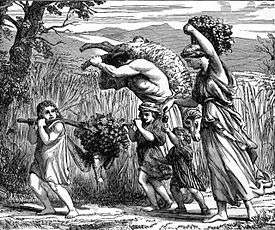
Exodus chapter 33
Reading Exodus 24:3, Rabbi Simlai taught that when the Israelites gave precedence to "we will do" over "we will hear," 600,000 ministering angels came and set two crowns on each Israelite man, one as a reward for "we will do" and the other as a reward for "we will hearken." But as soon as the Israelites committed the sin of the Golden Calf, 1.2 million destroying angels descended and removed the crowns, as it is said in Exodus 33:6, "And the children of Israel stripped themselves of their ornaments from mount Horeb."[167]
The Gemara reported a number of Rabbis' reports of how the Land of Israel did indeed flow with "milk and honey," as described in Exodus 3:8 and 17, 13:5, and 33:3, Leviticus 20:24, Numbers 13:27 and 14:8, and Deuteronomy 6:3, 11:9, 26:9 and 15, 27:3, and 31:20. Once when Rami bar Ezekiel visited Bnei Brak, he saw goats grazing under fig trees while honey was flowing from the figs, and milk dripped from the goats mingling with the fig honey, causing him to remark that it was indeed a land flowing with milk and honey. Rabbi Jacob ben Dostai said that it is about three miles from Lod to Ono, and once he rose up early in the morning and waded all that way up to his ankles in fig honey. Resh Lakish said that he saw the flow of the milk and honey of Sepphoris extend over an area of sixteen miles by sixteen miles. Rabbah bar Bar Hana said that he saw the flow of the milk and honey in all the Land of Israel and the total area was equal to an area of twenty-two parasangs by six parasangs.[168]

Rav Judah taught in the name of Rav that as Moses was dying, Joshua quoted back to Moses the report of Exodus 33:11 about how Joshua stood by the side of Moses all the time. Rav Judah reported in the name of Rav that when Moses was dying, he invited Joshua to ask him about any doubts that Joshua might have. Joshua replied by asking Moses whether Joshua had ever left Moses for an hour and gone elsewhere. Joshua asked Moses whether Moses had not written in Exodus 33:11, "The Lord would speak to Moses face to face, as one man speaks to another. . . . But his servant Joshua the son of Nun departed not out of the Tabernacle." Joshua's words wounded Moses, and immediately the strength of Moses waned, and Joshua forgot 300 laws, and 700 doubts concerning laws arose in Joshua's mind. The Israelites then arose to kill Joshua (unless he could resolve these doubts). God then told Joshua that it was not possible to tell him the answers (for, as Deuteronomy 30:11–12 tells, the Torah is not in Heaven). Instead, God then directed Joshua to occupy the Israelites' attention in war, as Joshua 1:1–2 reports.[169]
Rabbi Samuel bar Nahmani taught in the name of Rabbi Jonathan that the report of Exodus 33:11 helped to illuminate the words of Joshua 1:8 as a blessing. Ben Damah the son of Rabbi Ishmael's sister once asked Rabbi Ishmael whether one who had studied the whole Torah might learn Greek wisdom. Rabbi Ishmael replied by reading to Ben Damah Joshua 1:8, "This book of the law shall not depart out of your mouth, but you shall meditate therein day and night." And then Rabbi Ishmael told Ben Damah to go find a time that is neither day nor night and learn Greek wisdom then. Rabbi Samuel bar Nahmani, however, taught in the name of Rabbi Jonathan that Joshua 1:8 is neither duty nor command, but a blessing. For God saw that the words of the Torah were most precious to Joshua, as Exodus 33:11 says, "The Lord would speak to Moses face to face, as one man speaks to another. And he would then return to the camp. His minister Joshua, the son of Nun, a young man, departed not out of the tent." So God told Joshua that since the words of the Torah were so precious to him, God assured Joshua (in the words of Joshua 1:8) that "this book of the law shall not depart out of your mouth." A Baraita was taught in the School of Rabbi Ishmael, however, that one should not consider the words of the Torah as a debt that one should desire to discharge, for one is not at liberty to desist from them.[170]
A Midrash taught that Proverbs 27:18, "And he who waits on his master shall be honored," alludes to Joshua, for Joshua ministered to Moses day and night, as reported by Exodus 33:11, which says, "Joshua departed not out of the Tent," and Numbers 11:28, which says, "Joshua . . . said: ‘My lord Moses, shut them in.'" Consequently God honored Joshua by saying of Joshua in Numbers 27:21: "He shall stand before Eleazar the priest, who shall inquire for him by the judgment of the Urim." And because Joshua served his master Moses, Joshua attained the privilege of receiving the Holy Spirit, as Joshua 1:1 reports, "Now it came to pass after the death of Moses . . . that the Lord spoke to Joshua, the minister of Moses." The Midrash taught that there was no need for Joshua 1:1 to state, "the minister of Moses," so the purpose of the statement "the minister of Moses" was to explain that Joshua was awarded the privilege of prophecy because he was the minister of Moses.[171]
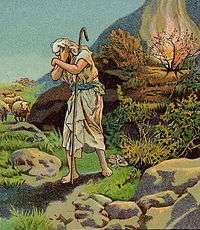
Rav Nachman taught that the angel of whom God spoke in Exodus 23:20 was Metatron (מטטרון). Rav Nahman warned that one who is as skilled in refuting heretics as Rav Idit should do so, but others should not. Once a heretic asked Rav Idit why Exodus 24:1 says, "And to Moses He said, ‘Come up to the Lord,'" when surely God should have said, "Come up to Me." Rav Idit replied that it was the angel Metatron who said that, and that Metatron's name is similar to that of his Master (and indeed the gematria (numerical value of the Hebrew letters) of Metatron (מטטרון) equals that of Shadai (שַׁדַּי), God's name in Genesis 17:1 and elsewhere) for Exodus 23:21 says, "for my name is in him." But if so, the heretic retorted, we should worship Metatron. Rav Idit replied that Exodus 23:21 also says, "Be not rebellious against him," by which God meant, "Do not exchange Me for him" (as the word for "rebel," (tamer, תַּמֵּר) derives from the same root as the word "exchange"). The heretic then asked why then Exodus 23:21 says, "he will not pardon your transgression." Rav Idit answered that indeed Metatron has no authority to forgive sins, and the Israelites would not accept him even as a messenger, for Exodus 33:15 reports that Moses told God, "If Your Presence does not go with me, do not carry us up from here."[172]
A Baraita taught in the name of Rabbi Joshua ben Korhah that God told Moses that when God wanted to be seen at the burning bush, Moses did not want to see God's face; Moses hid his face in Exodus 3:6, for he was afraid to look upon God. And then in Exodus 33:18, when Moses wanted to see God, God did not want to be seen; in Exodus 33:20, God said, "You cannot see My face." But Rabbi Samuel bar Nahmani said in the name of Rabbi Jonathan that in compensation for three pious acts that Moses did at the burning bush, he was privileged to obtain three rewards. In reward for hiding his face in Exodus 3:6, his face shone in Exodus 34:29. In reward his fear of God in Exodus 3:6, the Israelites were afraid to come near him in Exodus 34:30. In reward for his reticence "to look upon God," he beheld the similitude of God in Numbers 12:8.[173]
The Pirke De-Rabbi Eliezer told what happened in Exodus 33:18–34:6 after Moses asked to behold God's Presence in Exodus 33:18. Moses foretold that he would behold God's Glory and make atonement for the Israelites' iniquities on Yom Kippur. On that day, Moses asked God (in the words of Exodus 33:18) "Show me, I pray, Your Glory." God told Moses that Moses was not able to see God's Glory lest he die, as Exodus 33:20 reports God said, "men shall not see Me and live," but for the sake of God's oath to Moses, God agreed to do as Moses asked. God instructed Moses to stand at the entrance of a cave, and God would cause all God's angels to pass before Moses. God told Moses to stand his ground, and not to fear, as Exodus 33:19 reports, "And He said, I will make all My Goodness pass before you." God told Moses that when he heard the Name that God had spoken to him, then Moses would know that God was before him, as Exodus 33:19 reports. The ministering angels complained that they served before God day and night, and they were unable to see God's Glory, but this man Moses born of woman desired to see God's Glory. The angels arose in wrath and excitement to kill Moses, and he came near to death. God intervened in a cloud to protect Moses, as Exodus 34:5 reports, "And the Lord descended in the cloud." God protected Moses with the hollow of God's hand so that he would not die, as Exodus 33:22 reports, "And it shall come to pass, while My Glory passes by, that I will put you in a cleft of the rock, and I will cover you with My hand." When God had passed by, God removed the hollow of God's hand from Moses, and he saw traces of the Shechinah, as Exodus 33:23 says, "And I will take away My hand, and you shall see my back." Moses began to cry with a loud voice, and Moses said the words of Exodus 34:6–7: "O Lord, O Lord, a God full of compassion and gracious . . . ." Moses asked God to pardon the iniquities of the people in connection with the Golden Calf. God told Moses that if he had asked God then to pardon the iniquities of all Israel, even to the end of all generations, God would have done so, as it was the appropriate time. But Moses had asked for pardon with reference to the Golden Calf, so God told Moses that it would be according to his words, as Numbers 14:20 says, "And the Lord said, ‘I have pardoned according to your word.'"[174]
Rabbi Jose ben Halafta employed Exodus 33:21 to help explain how God can be called "the Place." Reading the words, "And he lighted upon the place," in Genesis 28:11 to mean, "And he met the Divine Presence (Shechinah)," Rav Huna asked in Rabbi Ammi's name why Genesis 28:11 assigns to God the name "the Place." Rav Huna explained that it is because God is the Place of the world (the world is contained in God, and not God in the world). Rabbi Jose ben Halafta taught that we do not know whether God is the place of God's world or whether God's world is God's place, but from Exodus 33:21, which says, "Behold, there is a place with Me," it follows that God is the place of God's world, but God's world is not God's place. Rabbi Isaac taught that reading Deuteronomy 33:27, "The eternal God is a dwelling place," one cannot know whether God is the dwelling-place of God's world or whether God's world is God's dwelling-place. But reading Psalm 90:1, "Lord, You have been our dwelling-place," it follows that God is the dwelling-place of God's world, but God's world is not God's dwelling-place. And Rabbi Abba ben Judan taught that God is like a warrior riding a horse with the warrior's robes flowing over on both sides of the horse. The horse is subsidiary to the rider, but the rider is not subsidiary to the horse. Thus Habakkuk 3:8 says, "You ride upon Your horses, upon Your chariots of victory."[175]
.jpg)

Exodus chapter 34
Rabban Johanan ben Zakkai explained why God carved the first two Tablets but Moses carved the second two, as God instructed in Exodus 34:1. Rabban Johanan ben Zakkai compared it to the case of a king who took a wife and paid for the paper for the marriage contract, the scribe, and the wedding dress. But when he saw her cavorting with one of his servants, he became angry with her and sent her away. Her agent came to the king and argued that she had been raised among servants and was thus familiar with them. The king told the agent that if he wished that the king should become reconciled with her, the agent should pay for the paper and the scribe for a new wedding contract and the king would sign it. Similarly, Moses spoke to God after the Israelites had committed the sin of the Golden Calf. Moses argued that God knew that God had brought the Israelites out of Egypt, a house of idolatry. Then God answered that if Moses desired that God should become reconciled with the Israelites, then Moses would have to bring the Tablets at his own expense and God would append God's signature, as God says in Exodus 34:1: "And I will write upon the tablets."[176]
In Deuteronomy 18:15, Moses foretold that "A prophet will the Lord your God raise up for you . . . like me," and Rabbi Johanan thus taught that prophets would have to be, like Moses, strong, wealthy, wise, and meek. Strong, for Exodus 40:19 says of Moses, "he spread the tent over the tabernacle," and a Master taught that Moses himself spread it, and Exodus 26:16 reports, "Ten cubits shall be the length of a board." Similarly, the strength of Moses can be derived from Deuteronomy 9:17, in which Moses reports, "And I took the two tablets, and cast them out of my two hands, and broke them," and it was taught that the Tablets were six handbreadths in length, six in breadth, and three in thickness. Wealthy, as Exodus 34:1 reports God's instruction to Moses, "Carve yourself two tablets of stone," and the Rabbis interpreted the verse to teach that the chips would belong to Moses. Wise, for Rav and Samuel both said that 50 gates of understanding were created in the world, and all but one were given to Moses, for Psalm 8:6 said of Moses, "You have made him a little lower than God." Meek, for Numbers 12:3 reports, "Now the man Moses was very meek."[177]
The Sifre taught that Exodus 34:6 demonstrates one of God's attributes that humans should emulate.[178] Rabbi Hama son of Rabbi Hanina asked what Deuteronomy 13:5 means in the text, "You shall walk after the Lord your God." How can a human being walk after God, when Deuteronomy 4:24 says, "[T]he Lord your God is a devouring fire"? Rabbi Hama son of Rabbi Hanina explained that the command to walk after God means to walk after the attributes of God. As God clothes the naked — for Genesis 3:21 says, "And the Lord God made for Adam and for his wife coats of skin, and clothed them" — so should we also clothe the naked. God visited the sick — for Genesis 18:1 says, "And the Lord appeared to him by the oaks of Mamre" (after Abraham was circumcised in Genesis 17:26) — so should we also visit the sick. God comforted mourners — for Genesis 25:11 says, "And it came to pass after the death of Abraham, that God blessed Isaac his son" — so should we also comfort mourners. God buried the dead — for Deuteronomy 34:6 says, "And He buried him in the valley" — so should we also bury the dead.[179] Similarly, the Sifre on Deuteronomy 11:22 taught that to walk in God's ways means to be (in the words of Exodus 34:6) "merciful and gracious."[180]
The Gemara reconciled apparent inconsistencies in God's attributes in Exodus 34:6–7. Rav Huna contrasted the description of God in two parts of Psalm 145:17. Rav Huna asked how, in the words of Psalm 145:17, God could be simultaneously "righteous in all his ways," and "gracious in all his works." (That is, how can God be simultaneously just and merciful?) At first, God is righteous, and in the end, gracious (when God sees that the world cannot endure strict justice). Similarly, Rabbi Eleazar contrasted two attributes reported in Psalm 62:13. Rabbi Eleazar asked how it could be simultaneously true that, in the words of Psalm 62:13, "to You, O Lord, belongs mercy," and "for You render to every man according to his work." At first, God "render[s] to every man according to his work," but at the end, "to You, O Lord, belongs mercy." Similarly, Ilfi (or others say Ilfa) contrasted two attributes. Exodus 34:6 reports that God is "abundant in goodness," and then Exodus 34:6 says, "and in truth." Ilfi asked how both could be true. At first, God exhibits "truth," and at the end, "abundant . . . goodness." Rabbi Johanan said that were it not written in Exodus 34:6–7, it would be impossible for mere humans to say such a thing took place. But Exodus 34:6–7 teaches that God drew a prayer shawl around God's self like the leader of congregational prayers and showed Moses the order of prayer. God told Moses that whenever Israel sins, they should recite the passage in Exodus 34:6–7 containing God's 13 attributes, and God would forgive them. The Gemara interpreted the words "The Lord, the Lord" in Exodus 34:6 to teach that God is the Eternal (exhibiting mercy) before humans sin and the same after they sin and repent. Rav Judah interpreted the words "a God merciful and gracious" in Exodus 34:6 to teach that with the 13 attributes, God made a covenant that Jews will not be turned away empty-handed when they recite the attributes, for soon thereafter, in Exodus 34:10, God says, "Behold I make a covenant."[181]
The Pirke De-Rabbi Eliezer told that God spoke to the Torah the words of Genesis 1:26, "Let us make man in our image, after our likeness." The Torah answered that the man whom God sought to create would be limited in days and full of anger, and would come into the power of sin. Unless God would be long-suffering with him, the Torah continued, it would be well for man not to come into the world. God asked the Torah whether it was for nothing that God is called (echoing Exodus 34:6) "slow to anger" and "abounding in love."[182] God then set about making man.[183]
.jpg)
Rabbi Jose interpreted the words "forgiving iniquity and transgression and sin; and that will by no means clear the guilty" in Exodus 34:7 to teach that a person who sins once, twice, or even three times is forgiven, but one who sins four times is not forgiven. Rabbi Jose cited for support Amos 2:6, where God says, "for three transgressions of Israel," God would not reverse God's forgiveness, and Job 33:29, which says, "God does these things twice, yea thrice, with a man."[184]

A Baraita taught that when Moses ascended to receive the Torah from God, Moses found God writing "longsuffering" among the words with which Exodus 34:8 describes God. Moses asked God whether God meant longsuffering with the righteous, to which God replied that God is longsuffering even with the wicked. Moses exclaimed that God could let the wicked perish, but God cautioned Moses that Moses would come to desire God's longsuffering for the wicked. Later, when the Israelites sinned at the incident of the spies, God reminded Moses that he had suggested that God be longsuffering only with the righteous, to which Moses recounted that God had promised to be longsuffering even with the wicked. And that is why Moses in Numbers 14:17–18 cited to God that God is "slow to anger."[185]
Tractate Beitzah in the Mishnah, Tosefta, Jerusalem Talmud, and Babylonian Talmud interpreted the laws common to all of the festivals in Exodus 12:3–27, 43–49; 13:6–10; 23:16; 34:18–23; Leviticus 16; 23:4–43; Numbers 9:1–14; 28:16–30:1; and Deuteronomy 16:1–17; 31:10–13.[186]
Tractate Bekhorot in the Mishnah, Tosefta, and Talmud interpreted the laws of the firstborn in Exodus 13:1–2, 12–13; 22:28–29; and 34:19–20; and Numbers 3:13 and 8:17.[187] Elsewhere, the Mishnah interpreted Exodus 34:20 to allow money in exchange for redemption of a first-born son to be given to any priest (כֹּהֵן, kohen);[188] that if a person weaves the hair of a firstborn donkey into a sack, the sack must be burned;[189] that they did not redeem with the firstborn of a donkey an animal that falls within both wild and domestic categories (a koy);[190] and that one was prohibited to derive benefit in any quantity at all from an unredeemed firstborn donkey.[191] And elsewhere, the Mishnah taught that before the Israelites constructed the Tabernacle, the firstborns performed sacrificial services, but after the Israelites constructed the Tabernacle, the Priests (כֹּהֲנִים, Kohanim) performed the services.[192]
Rabbi Akiva interpreted Exodus 34:21 to prohibit plowing prior to the Sabbatical year (Shmita) that would reap benefits in the Sabbatical year and to prohibit reaping in the year after the Sabbatical year produce that grew in the Sabbatical year. Rabbi Ishamel argued, however, that Exodus 34:21 applied to the Sabbath, and limited its prohibition to plowing and reaping not elsewhere required by commandment.[193]
Tractate Sukkah in the Mishnah, Tosefta, Jerusalem Talmud, and Babylonian Talmud interpreted the laws of Sukkot in Exodus 23:16; and 34:22; Leviticus 23:33–43; Numbers 29:12–34; and Deuteronomy 16:13–17; and 31:10–13.[194]
Tractate Pesachim in the Mishnah, Tosefta, Jerusalem Talmud, and Babylonian Talmud interpreted the laws of the Passover in Exodus 12:3–27, 43–49; 13:6–10; 23:15; 34:25; Leviticus 23:4–8; Numbers 9:1–14; 28:16–25; and Deuteronomy 16:1–8.[195]
The Mishnah noted differences between the first Passover in Exodus 12:3–27, 43–49; 13:6–10; 23:15; 34:25; Leviticus 23:4–8; Numbers 9:1–14; 28:16–25; and Deuteronomy 16:1–8. and the second Passover in Numbers 9:9–13. The Mishnah taught that the prohibitions of Exodus 12:19 that "seven days shall there be no leaven found in your houses" and of Exodus 13:7 that "no leaven shall be seen in all your territory" applied to the first Passover; while at the second Passover, one could have both leavened and unleavened bread in one's house. And the Mishnah taught that for the first Passover, one was required to recite the Hallel (Psalms 113–118) when the Passover lamb was eaten; while the second Passover did not require the reciting of Hallel when the Passover lamb was eaten. But both the first and second Passovers required the reciting of Hallel when the Passover lambs were offered, and both Passover lambs were eaten roasted with unleavened bread and bitter herbs. And both the first and second Passovers took precedence over the Sabbath.[196]
The Mishnah taught that they buried meat that had mixed with milk in violation of Exodus 23:19 and 34:26 and Deuteronomy 14:21.[197]
Rabbi Simeon ben Yohai taught that because the generation of the Flood transgressed the Torah that God gave humanity after Moses had stayed on the mountain for 40 days and 40 nights (as reported in Exodus 24:18 and 34:28 and Deuteronomy 9:9–11, 18, 25, and 10:10), God announced in Genesis 7:4 that God would "cause it to rain upon the earth 40 days and 40 nights."[198]
In medieval Jewish interpretation
The parashah is discussed in these medieval Jewish sources:[199]

Exodus chapter 32
Rashi reported an interpretation by Rabbi Moses HaDarshan (the preacher) that since the Levites were submitted in atonement for the firstborn who had practiced idolatry when they worshipped the Golden Calf (in Exodus 32), and Psalm 106:28 calls idol worship "sacrifices to the dead," and in Numbers 12:12 Moses called one afflicted with skin disease (צָּרַעַת, tzara'at) "as one dead," and Leviticus 14:8 required those afflicted with skin disease to shave, therefore God required the Levites too to shave.[200]
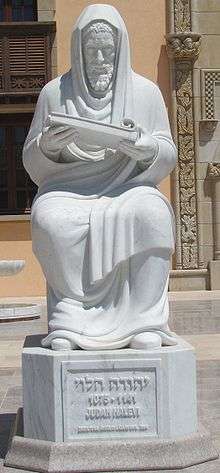
Exodus chapter 34
Interpreting the attributes of God in Exodus 34:6–7, Judah Halevi argued that all characterizations of God, except for the four-letter Name of God, the Tetragrammaton, are predicates and attributive descriptions, derived from the way God's actions affect the world. People call God "merciful" if God improves the condition of someone whom people pity. People attribute to God "mercy" and "compassion," although Halevi saw these attributes as weaknesses of the soul and a quick movement of nature. Halevi argued that this cannot actually be applied to God, who is a just Judge, ordaining poverty for one and wealth to another. God's nature, Halevi argued, remains unaffected, having no sympathy for one, nor anger for another. God decides according to law, making some people happy and others miserable. God appears to people, as we observe God's actions, sometimes (in the words of Exodus 34:6) as a "merciful and compassionate God," and sometimes (in the words of Nahum 1:2) as "a jealous and revengeful God," while in reality God never changes. Halevi divided all attributes (apart from the Tetragrammaton) into three classes: creative, relative, and negative. And he ideintified as creative attributes those derived from God's effect on the world, such as making poor and rich, lifting up or casting down, "merciful and compassionate," "jealous and revengeful," "strong and almighty," and the like.[201]

Similarly, Maimonides equated knowledge of God's attributes with knowledge of God's works. Because in Exodus 34:6–7, God taught Moses attributes that refer solely to God's works, Maimonides inferred that God had promised to give Moses a knowledge of God's works. Maimonides thus concluded that the ways that Moses wished to know, and which God taught him, were God's actions. Maimonides equated these with what the Sages called "attributes" (מִדּוֹת, middot), noting that the Talmud spoke of the 13 "attributes" (מִדּוֹת, middot) of God.[202] And the Mishnah also used the term in reference to man, saying, for example, "There are four different sorts (מִדּוֹת, middot) among those who go to the house of learning," and, "There are four different traits (מִדּוֹת, middot) among those who give charity."[203] Maimonides argued that the Sages did not mean that God really possesses attributes, but that God performs actions similar to human actions that in humans flow from certain attributes and certain mental dispositions, whereas God has no such dispositions. Although Moses was shown all God's goodness, that is, all God's works, Exodus 34:6–7 mentions only the 13 attributes, because they include those acts of God that refer to the creation and the government of mankind, and to know these acts was the principal object of the prayer of Moses. Maimonides found evidence for this in the conclusion of the prayer of Moses in Exodus 33:16, "that I may know You, that I may find grace in Your sight, and consider that this nation is Your people." That is, Moses sought understanding of God's ways in governing the Israelites, so that Moses might act similarly. Maimonides concluded that "the ways" used in the Bible are identical with the "attributes" used in the Mishnah, denoting the acts emanating from God in reference to the universe.[204]

The Zohar, however, found in God's Attributes components of God's essential Name. In the Zohar, Rabbi Simeon taught from the Book of Mystery that the Divine Name has both a revealed and a concealed form. In its revealed form, it is written as the four-letter Name of God, the Tetragrammaton, but in its undisclosed form it is written in other letters, and this undisclosed form represents the most Recondite of all. In the Zohar, Rabbi Judah taught that even the revealed form of the Name is hidden under other letters (as the name ADoNaY, אֲדֹנָי, is hidden within ADNY, אדני) in order to screen the most Recondite of all. In the letters of God's Name are concealed 22 attributes of Mercy, namely, the 13 attributes of God in Exodus 34:6–7 and nine attributes of the Mikroprosopus, the lesser revealed aspect of God. They all combine in one composite Name. When people were more reverent, the priests openly enunciated the Name in the hearing of all, but after irreverence became widespread, the Name became concealed under other letters. At the time when the Name was disclosed, the priest would concentrate his mind on its deep and inner meaning, and he would utter the Name in such a way as to accord with that meaning. But when irreverence became common in the world, he would conceal all within the written letters. The Zohar taught that Moses uttered the 22 letters in two sections, first in Exodus 34:6–7 in the attributes of God, and second in Numbers 14:18, when he uttered nine attributes of Mercy that are inherent in the Mikroprosopus, and which are radiated from the light of God. All this the priest combined together when he spread forth his hands to bless the people pursuant to Numbers 6:23–26, so that all the worlds received God's blessings. It is for this reason that Numbers 6:23 says simply "saying" (אָמוֹר, amor), instead of the imperative form "say" (אִמְרִי, imri), in a reference to the hidden letters within the words of the Priestly Blessing. The word אָמוֹר, amor has in its letters the numerical value of 248 minus one (א equals 1; מ equals 40; ו equals 6; ר equals 200; and 1 + 40 + 6 + 200 = 247), equal to the number of a man's bodily parts, excepting the one part on which all the rest depend. All these parts thus receive the Priestly Blessing as expressed in the three verses of Numbers 6:24–26.[205]
In modern interpretation
The parashah is discussed in these modern sources:
Exodus chapter 30
Exodus 30:13 reports that "the shekel is twenty gerahs." This table translates units of weight used in the Bible into their modern equivalents:[206]
| Unit | Texts | Ancient Equivalent | Modern Equivalent |
|---|---|---|---|
| gerah (גֵּרָה) | Exodus 30:13; Leviticus 27:25; Numbers 3:47; 18:16; Ezekiel 45:12 | 1/20 shekel | 0.6 gram; 0.02 ounce |
| bekah (בֶּקַע) | Genesis 24:22; Exodus 38:26 | 10 gerahs; half shekel | 6 grams; 0.21 ounce |
| pim (פִים) | 1 Samuel 13:21 | 2/3 shekel | 8 grams; 0.28 ounce |
| shekel (שֶּׁקֶל) | Exodus 21:32; 30:13, 15, 24; 38:24, 25, 26, 29 | 20 gerahs; 2 bekahs | 12 grams; 0.42 ounce |
| mina (maneh, מָּנֶה) | 1 Kings 10:17; Ezekiel 45:12; Ezra 2:69; Nehemiah 7:70 | 50 shekels | 0.6 kilogram; 1.32 pounds |
| talent (kikar, כִּכָּר) | Exodus 25:39; 37:24; 38:24, 25, 27, 29 | 3,000 shekels; 60 minas | 36 kilograms; 79.4 pounds |
Exodus chapter 34
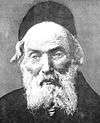
The Chofetz Chaim told a parable to explain the teaching of Rav Judah (see "In classical rabbinic interpretation": "Exodus chapter 34" above) that God would not turn Jews away empty-handed when they recite the 13 attributes of God in Exodus 34:6–7. The Chofetz Chaim told that there was once a wealthy businessman whose poor nephew pleaded with him for a job. The businessman gave the nephew a job, and wrote out a list of tasks describing the nephew's responsibilities. The businessman exhorted the nephew to review the list every day. After a while, the businessman summoned his nephew to ask him what he was doing for the business. The nephew said that he had done everything that the businessman had asked. The businessman pressed the nephew for details. The nephew replied that every day, he recited the list of tasks that the businessman gave him and remembered the list by heart. The businessman asked whether the nephew had done any of the tasks. The nephew answered sheepishly that he thought that since his uncle was the boss, it would be enough for him simply to repeat the list aloud. The businessman called the nephew a fool and explained that the list was only to remind the nephew what to do. Similarly, taught the Chofetz Chaim, the 13 attributes, while given to Jews to be recited as a prayer, are fundamentally guidelines for how to walk in God's ways.[207]
Professor Phyllis Trible, formerly of Wake Forest University School of Divinity, noted that the adjective "merciful" (רַחוּם, rachum), used in Exodus 34:6 as one of God's attributes, is tied to the noun "womb" or "uterus" (רֶחֶם, rechem). Trible wrote that the Hebrew noun for "compassion" or "mercy" (רַחֲמִים, rahamim) thus connotes both a "mode of being and the locus of that mode," as in the Hebrew the concrete meaning of "womb" expanded to encompass the abstractions of "compassion," "mercy," and "love," the verb "to show mercy" (רחם, rchm), and the adjective "merciful" (רַחוּם, rachum).[208]
Commandments
According to Sefer ha-Chinuch, there are 4 positive and 5 negative commandments in the parashah:[209]
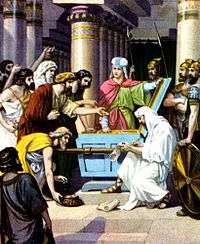
- To give a half shekel annually[210]
- A Kohen must wash his hands and feet before service.[211]
- To prepare the anointing oil[212]
- Not to anoint with anointing oil[213]
- Not to reproduce the anointing oil[213]
- Not to reproduce the incense formula[214]
- Not to eat or drink anything from an offering to an idol[215]
- To let the land lie fallow in the Sabbatical year[216]
- Not to cook meat and milk together[217]
Maimonides, however, attributed to this parashah only the following 4 positive and 3 negative commandments:[218]
- To give a half shekel annually[210]
- A Kohen must wash his hands and feet before service.[211]
- To prepare the anointing oil[212]
- Not to reproduce the anointing oil[213]
- Not to anoint with anointing oil[213]
- Not to reproduce the incense formula[214]
- To let the land lie fallow in the Sabbatical year[216]
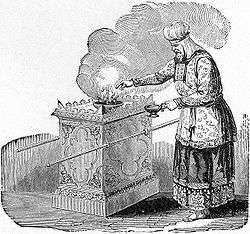
In the liturgy
Some Jews read the descriptions of the laver in Exodus 30:17–21 and Aaron's incense offerings in Exodus 30:7–8 and 30:34–36 after the Sabbath morning blessings.[219]
Some Jews sing of the Sabbath's holiness, reflecting Exodus 31:14, as part of the Baruch El Elyon song (zemer) sung in connection with the Sabbath day meal.[220]
Jews recite the account of the Sabbath's significance in Exodus 31:16–17 as the final reading concluding the blessings of the Shema before the punctuating half-Kaddish and the Amidah prayer in the Friday Sabbath evening (Maariv) prayer service.[221] The exhortation to "observe" (V'shamru, ושמרו) the Sabbath that this reading concludes reflects God's command in Exodus 31:13 to "keep My Sabbaths," even to the exclusion of other apparently worthy causes.[222] Again, Jews recite the account of the Sabbath's significance in Exodus 31:16–17 as part of the V'shamru paragraph of the Amidah prayer in the Sabbath morning (Shacharit) prayer service.[223] And once again, Jews recite the account of the Sabbath's significance in Exodus 31:16–17 as part of the V'shamru paragraph of the Kiddusha Rabba blessing for the Sabbath day meal.[224]
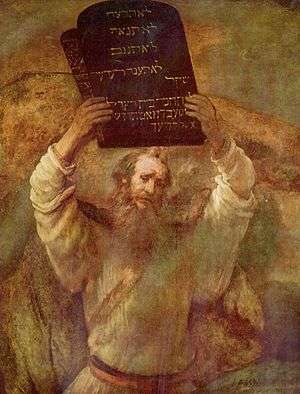
The second blessing before the Shema addresses God about "your people" Israel, as Moses does in Exodus 32:11–12.[225]
Jews recite the account of how Moses brought down two Tablets of stone reported in Exodus 32:15 as part of the Amidah prayer in the Sabbath morning (Shacharit) prayer service.[226]
Some Jews refer to the inscription on the two Tablets of stone reported in Exodus 32:15 as they study Pirkei Avot chapter 5 on a Sabbath between Passover and Rosh Hashanah.[227] And thereafter, some quote Exodus 32:16 as they study Pirkei Avot chapter 6 on a succeeding Sabbath between Passover and Rosh Hashanah.[228]
God's characteristics of graciousness and compassion in Exodus 34:6 are reflected in Psalm 145:8 and in turn in the Ashrei prayer in the morning (Shacharit) and afternoon (Mincha) prayer services. Similarly, Jews call on God's characteristic of forgiveness in Exodus 34:6 with the words "forgive us, our Guide" in the weekday Amidah prayer in each of the three prayer services. And again, Jews cite God's characteristic of "steadfast lovingkindness (rav chesed)" in Exodus 34:6 in the Kedushah D'Sidra section of the Minchah service for Shabbat.[229]
Jews recite three times the 13 attributes of mercy in Exodus 34:6–7 after removing the Torah from the Ark on Passover, Shavuot, Rosh Hashanah, Yom Kippur, Sukkot, and Hoshana Rabbah.[230]
During the Amidah prayer in the Sabbath morning (Shacharit) prayer service, Jews refer to the "crown of splendor" that God placed on Moses in Exodus 34:29.[231]
The weekly maqam
In the Weekly Maqam, Sephardi Jews each week base the songs of the services on the content of that week's parashah. For Parashah Ki Tisa, Sephardi Jews apply Maqam Hijaz, the maqam that expresses mourning and sorrow, as the parashah contains the episode of the Golden Calf, a sad and embarrassing episode in the history of the Israelite people.[232]
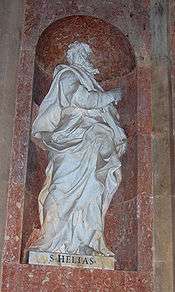
Haftarah
Generally
The haftarah for the parashah is:
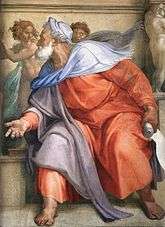
Connection to the Parashah
Both the parashah and the haftarah in First Kings describe God's prophet confronting idolatry to restore worship of God, the parashah in Moses' anger at the Golden Calf,[233] and the haftarah in the prophet Elijah's confrontation with the prophets of Baal.[234] In both the parashah and the haftarah, the prophet was on a mountain;[235] the prophet invoked the names of Abraham and Isaac in prayer to God;[236] sound (kol) is observed;[237] the prophet called on the Israelites to choose between God and the false god;[238] and God manifested God's choice.[239]
On Shabbat Parah
When the parashah coincides with Shabbat Parah (the special Sabbath prior to Passover — as it does in 2013 and 2017), the haftarah is Ezekiel 36:16–38. On Shabbat Parah, the Sabbath of the red heifer, Jews read Numbers 19:1–22, which describes the rites of purification using the red heifer (parah adumah). Similarly, the haftarah in Ezekiel also describes purification. In both the special reading and the haftarah in Ezekiel, sprinkled water cleansed the Israelites.[240]
See also
Notes
- ↑ "Torah Stats — Shemoth". Akhlah Inc. Retrieved July 7, 2013.
- ↑ "Parashat Ki Tisa". Hebcal. Retrieved February 9, 2015.
- ↑ See, e.g., The Schottenstein Edition Interlinear Chumash: Shemos/Exodus. Edited by Menachem Davis, pages 225–62. Brooklyn: Mesorah Publications, 2006. ISBN 1-4226-0204-4.
- ↑ Exodus 30:11–15.
- ↑ Exodus 30:16.
- ↑ See, e.g., The Schottenstein Edition Interlinear Chumash: Shemos/Exodus. Edited by Menachem Davis, page 227.
- ↑ Exodus 30:17–21.
- ↑ See, e.g., The Schottenstein Edition Interlinear Chumash: Shemos/Exodus. Edited by Menachem Davis, page 228.
- ↑ Exodus 30:22–25.
- ↑ Exodus 30:26–30.
- ↑ Exodus 30:31–33.
- ↑ See, e.g., The Schottenstein Edition Interlinear Chumash: Shemos/Exodus. Edited by Menachem Davis, page 230.
- ↑ Exodus 30:34–36.
- ↑ Exodus 30:37–38.
- ↑ See, e.g., The Schottenstein Edition Interlinear Chumash: Shemos/Exodus. Edited by Menachem Davis, page 231.
- ↑ Exodus 31:1–5.
- ↑ Exodus 31:6–11.
- ↑ See, e.g., The Schottenstein Edition Interlinear Chumash: Shemos/Exodus. Edited by Menachem Davis, page 233.
- ↑ Exodus 31:12–17.
- ↑ See, e.g., The Schottenstein Edition Interlinear Chumash: Shemos/Exodus. Edited by Menachem Davis, pages 234–35.
- ↑ Exodus 31:18.
- ↑ Exodus 32:1.
- ↑ Exodus 32:2–4.
- ↑ Exodus 32:4.
- ↑ Exodus 32:5.
- ↑ Exodus 32:6.
- ↑ See, e.g., The Schottenstein Edition Interlinear Chumash: Shemos/Exodus. Edited by Menachem Davis, page 238.
- ↑ Exodus 32:7–10.
- ↑ Exodus 32:11–12.
- ↑ Exodus 32:13–14.
- ↑ See, e.g., The Schottenstein Edition Interlinear Chumash: Shemos/Exodus. Edited by Menachem Davis, page 240.
- ↑ Exodus 32:15–16.
- ↑ Exodus 32:17–18.
- ↑ Exodus 32:19.
- ↑ Exodus 32:20.
- ↑ Exodus 32:21–24.
- ↑ Exodus 32:25–26.
- ↑ Exodus 32:27–29.
- ↑ Exodus 32:31–35.
- ↑ See, e.g., The Schottenstein Edition Interlinear Chumash: Shemos/Exodus. Edited by Menachem Davis, page 245.
- ↑ Exodus 33:1–3.
- ↑ Exodus 33:4.
- ↑ Exodus 33:7–11.
- ↑ See, e.g., The Schottenstein Edition Interlinear Chumash: Shemos/Exodus. Edited by Menachem Davis, at 248–49.
- ↑ Exodus 33:12.
- ↑ Exodus 33:13.
- ↑ Exodus 33:14.
- ↑ Exodus 33:15–16.
- ↑ See, e.g., The Schottenstein Edition Interlinear Chumash: Shemos/Exodus. Edited by Menachem Davis, page 250.
- ↑ Exodus 33:17.
- ↑ Exodus 33:18.
- ↑ Exodus 33:19–20.
- ↑ Exodus 33:21–23.
- ↑ See, e.g., The Schottenstein Edition Interlinear Chumash: Shemos/Exodus. Edited by Menachem Davis, page 252.
- ↑ Exodus 34:1–4.
- ↑ Exodus 34:5–7.
- ↑ Exodus 34:8–9.
- ↑ See, e.g., The Schottenstein Edition Interlinear Chumash: Shemos/Exodus. Edited by Menachem Davis, page 256.
- ↑ Exodus 34:10–11.
- ↑ Exodus 34:12–16.
- ↑ Exodus 34:17–26.
- ↑ See, e.g., The Schottenstein Edition Interlinear Chumash: Shemos/Exodus. Edited by Menachem Davis, page 260.
- ↑ Exodus 34:28.
- ↑ Exodus 34:29–30.
- ↑ Exodus 34:31–32.
- ↑ See, e.g., The Schottenstein Edition Interlinear Chumash: Shemos/Exodus. Edited by Menachem Davis, pages 261–62.
- ↑ Exodus 34:33.
- ↑ Exodus 34:34.
- ↑ Exodus 34:34–35.
- ↑ See, e.g., The Schottenstein Edition Interlinear Chumash: Shemos/Exodus. Edited by Menachem Davis, page 262.
- ↑ See, e.g., "A Complete Triennial Cycle for Reading the Torah" (PDF). The Jewish Theological Seminary. Retrieved June 16, 2014.
- ↑ For more on inner-Biblical interpretation, see, e.g., Benjamin D. Sommer. “Inner-biblical Interpretation.” In The Jewish Study Bible: Second Edition. Edited by Adele Berlin and Marc Zvi Brettler, pages 1835–41. New York: Oxford University Press, 2014. ISBN 978-0-19-997846-5.
- ↑ See generally Jon D. Levenson. "Cosmos and Microcosm." In Creation and the Persistence of Evil: The Jewish Drama of Divine Omnipotence, pages 78–99. San Francisco: Harper & Row, 1988. ISBN 0-06-254845-X. See also Jeffrey H. Tigay. “Exodus.” In The Jewish Study Bible: Second Edition. Edited by Adele Berlin and Marc Zvi Brettler, page 157.
- ↑ (1) Genesis 1:1–5; (2) 1:6–8; (3) 1:9–13; (4) 1:14–19; (5) 1:20–23; (6) 1:24–31; (7) Genesis 2:1–3.
- ↑ (1) Exodus 25:1–30:10; (2) 30:11–16; (3) 30:17–21; (4) 30:22–33; (5) 30:34–37; (6) 31:1–11; (7) 31:12–17.
- ↑ Genesis 2:1; Exodus 39:32.
- ↑ Genesis 1:31; Exodus 39:43.
- ↑ Genesis 2:2; Exodus 40:33–34.
- ↑ Genesis 2:3; Exodus 39:43.
- ↑ Genesis 2:3; Exodus 40:9–11.
- ↑ See generally Sorel Goldberg Loeb and Barbara Binder Kadden. Teaching Torah: A Treasury of Insights and Activities, page 157. Denver: A.R.E. Publishing, 1997. ISBN 0-86705-041-1.
- ↑ Jeffrey H. Tigay. “Exodus.” In The Jewish Study Bible: Second Edition. Edited by Adele Berlin and Marc Zvi Brettler, page 157.
- ↑ Exodus 25:37.
- ↑ Exodus 28:1–39.
- ↑ Compare Exodus 39:32 to Genesis 2:1–3; Exodus 39:43 to Genesis 1:31; and Exodus 40:33 to Genesis 2:2.
- ↑ Exodus 40:17.
- ↑ Carol Meyers. “Exodus.” In The New Oxford Annotated Bible: New Revised Standard Version With The Apocrypha: An Ecumenical Study Bible. Edited by Michael D. Coogan, Marc Z. Brettler, Carol A. Newsom, and Pheme Perkins, page 117. New York: Oxford University Press, Revised 4th Edition 2010. ISBN 0-19-528955-2.
- ↑ 1 Kings 12:26–28.
- ↑ 1 Kings 12:29–30.
- ↑ 1 Kings 12:31.
- ↑ 1 Kings 12:32-33.
- ↑ Exodus 12:11, 21, 27, 43, 48; 34:25; Leviticus 23:5; Numbers 9:2, 4–6, 10, 12–14; 28:16; 33:3; Deuteronomy 16:1–2, 5–6; Joshua 5:10–11; 2 Kings 23:21–23; Ezekiel 45:21; Ezra 6:19–20; 2 Chronicles 30:1–2, 5, 15, 17–18; 35:1, 6–9, 11, 13, 16–19.
- ↑ Exodus 12:17; 23:15; 34:18; Leviticus 23:6; Deuteronomy 16:16; Ezekiel 45:21; Ezra 6:22; 2 Chronicles 8:13; 30:13, 21; 35:17.
- ↑ Exodus 12:16; Leviticus 23:7–8; Numbers 28:18, 25.
- ↑ See, e.g., W. Gunther Plaut. The Torah: A Modern Commentary, page 456. New York: Union of American Hebrew Congregations, 1981. ISBN 0-8074-0055-6.
- 1 2 W. Gunther Plaut, The Torah: A Modern Commentary, page 464.
- ↑ Exodus 12:11, 21, 27, 43, 48; Deuteronomy 16:2, 5–6; Ezra 6:20; 2 Chronicles 30:15, 17–18; 35:1, 6–9, 11, 13.
- ↑ Exodus 12:42; 23:15; 34:18; Numbers 33:3; Deuteronomy 16:1, 3, 6.
- ↑ Exodus 34:22; Deuteronomy 16:10; see also 2 Chronicles 8:13 (חַג הַשָּׁבֻעוֹת, Chag haShavuot).
- ↑ Numbers 28:26.
- 1 2 Exodus 23:16.
- ↑ Leviticus 23:21; Numbers 28:26.
- ↑ See also Exodus 23:16; Leviticus 23:17; Numbers 28:26.
- ↑ Leviticus 23:34; Deuteronomy 16:13, 16; 31:10; Zechariah 14:16, 18, 19; Ezra 3:4; 2 Chronicles 8:13.
- ↑ Exodus 23:16, 34:22.
- 1 2 1 Kings 8:2, 65; 12:32; 2 Chronicles 5:3; 7:8.
- 1 2 Leviticus 23:39; Judges 21:19.
- ↑ Ezekiel 45:25; Nehemiah 8:14.
- ↑ Numbers 29:12.
- ↑ Deuteronomy 16:13.
- ↑ Compare Judges 9:27.
- ↑ Isaiah 1:8.
- ↑ Deuteronomy 31:10–11.
- ↑ 1 Kings 8; 2 Chronicles 7.
- ↑ Ezra 3:2–4.
- ↑ Nehemiah 8:13–17.
- ↑ Nehemiah 8:14–15.
- ↑ Leviticus 23:42–43.
- ↑ Numbers 11:10; 16:27.
- ↑ E.g., Richard Elliott Friedman. The Bible with Sources Revealed, pages 228–29. New York: HarperSanFrancisco, 2003.
- ↑ 1 Kings 12:32–33.
- ↑ 1 Kings 13:1.
- ↑ Zechariah 14:16–19.
- ↑ For more on early nonrabbinic interpretation, see, e.g., Esther Eshel. “Early Nonrabbinic Interpretation.” In The Jewish Study Bible: Second Edition. Edited by Adele Berlin and Marc Zvi Brettler, pages 1841–59.
- ↑ Josephus. Antiquities of the Jews book 3, chapter 6, paragraph 1, clause 104. Circa 93–94. Reprinted in, e.g., The Works of Josephus: Complete and Unabridged, New Updated Edition. Translated by William Whiston, page 86. Peabody, Massachusetts: Hendrickson Publishers, 1987. ISBN 0-913573-86-8.
- ↑ For more on classical rabbinic interpretation, see, e.g., Yaakov Elman. “Classical Rabbinic Interpretation.” In The Jewish Study Bible: Second Edition. Edited by Adele Berlin and Marc Zvi Brettler, pages 1859–78.
- ↑ Babylonian Talmud Taanit 8b. Babylonia, 6th century. Reprinted in, e.g., Talmud Bavli. Elucidated by Mordechai Kuber and Michoel Weiner; edited by Hersh Goldwurm, volume 19, pages 8b2–3. Brooklyn: Mesorah Publications, 1991. ISBN 1-57819-619-1.
- ↑ Babylonian Talmud Bava Batra 10b.
- ↑ Babylonian Talmud Berakhot 62b. Reprinted in, e.g., Talmud Bavli. Elucidated by Yosef Widroff, Mendy Wachsman, Israel Schneider, and Zev Meisels; edited by Yisroel Simcha Schorr and Chaim Malinowitz, volume 2, page 62b3–5. Brooklyn: Mesorah Publications, 1997. ISBN 1-57819-601-9.
- ↑ Mishnah Shekalim 1:1–4:9. Land of Israel, circa 200 CE. Reprinted in, e.g., The Mishnah: A New Translation. Translated by Jacob Neusner, pages 251–58. New Haven: Yale University Press, 1988. ISBN 0-300-05022-4. Tosefta Shekalim 1:1–3:1. Land of Israel, circa 300 CE. Reprinted in, e.g., The Tosefta: Translated from the Hebrew, with a New Introduction. Translated by Jacob Neusner, volume 1, pages 523–39. Peabody, Massachusetts: Hendrickson Publishers, 2002. ISBN 1-56563-642-2. Jerusalem Talmud Shekalim 1a–. Land of Israel, circa 400 CE. Babylonian Talmud Shekalim 2a–13a.
- ↑ Pirke De-Rabbi Eliezer, chapter 48. Early 9th century. Reprinted in, e.g., Pirke de Rabbi Eliezer. Translated and annotated by Gerald Friedlander, pages 382–83. London, 1916. Reprinted New York: Hermon Press, 1970. ISBN 0-87203-183-7.
- ↑ Mishnah Zevachim 2:1. Reprinted in, e.g., The Mishnah: A New Translation. Translated by Jacob Neusner, pages 700–01. Babylonian Talmud Zevachim 15b. Reprinted in, e.g., Talmud Bavli. Elucidated by Abba Zvi Naiman, Israel Schneider, and Michoel Weiner; edited by Yisroel Simcha Schorr and Chaim Malinowitz, volume 55, page 15b3. Brooklyn: Mesorah Publications, 1995. ISBN 1-57819-612-4.
- ↑ Babylonian Talmud Zevachim 19b. Reprinted in, e.g., Talmud Bavli. Elucidated by Abba Zvi Naiman, Israel Schneider, and Michoel Weiner; edited by Yisroel Simcha Schorr and Chaim Malinowitz, volume 55, page 19b2.
- ↑ Mishnah Yoma 3:10. Reprinted in, e.g., The Mishnah: A New Translation. Translated by Jacob Neusner, page 269. Babylonian Talmud Yoma 37a. Babylonia, 6th century. Reprinted in, e.g., Koren Talmud Bavli: Yoma. Commentary by Adin Even-Israel (Steinsaltz), volume 9, page 174. Jerusalem: Koren Publishers, 2013. ISBN 978-965-301-570-8.
- ↑ Mishnah Keritot 1:1–2. Reprinted in, e.g., The Mishnah: A New Translation. Translated by Jacob Neusner, pages 836–37. Babylonian Talmud Keritot 2a. Reprinted in, e.g., Talmud Bavli. Elucidated by Eliahu Shulman, Dovid Arye Kaufman, Dovid Nachfolger, Menachem Goldberger, Michoel Weiner, Mendy Wachsman, Abba Zvi Naiman, and Zev Meisels; edited by Yisroel Simcha Schorr and Chaim Malinowitz, volume 69, pages 2a1–5. Brooklyn: Mesorah Publications, 2004. ISBN 1-57819-656-6.
- ↑ Babylonian Talmud Keritot 5b. Reprinted in, e.g., Talmud Bavli. Elucidated by Eliahu Shulman, Dovid Arye Kaufman, Dovid Nachfolger, Menachem Goldberger, Michoel Weiner, Mendy Wachsman, Abba Zvi Naiman, and Zev Meisels; edited by Yisroel Simcha Schorr and Chaim Malinowitz, volume 69, page 5b1.
- ↑ Babylonian Talmud Berakhot 55a. Reprinted in, e.g., Koren Talmud Bavli: Berakhot. Commentary by Adin Even-Israel (Steinsaltz), volume 1, pages 356–57. Jerusalem: Koren Publishers, 2012. ISBN 978-965-301-563-0.
- ↑ Jerusalem Talmud Peah 5a. Reprinted in, e.g., Talmud Yerushalmi. Elucidated by Feivel Wahl, Henoch Moshe Levin, Menachem Goldberger, Avrohom Neuberger, Mendy Wachsman, Michoel Weiner, and Abba Zvi Naiman; edited by Chaim Malinowitz, Yisroel Simcha Schorr, and Mordechai Marcus, volume 3, page 5a2. Brooklyn: Mesorah Publications, 2006. ISBN 1-4226-0236-2.
- ↑ Agadat Shir ha-Shirim 5, 36–37. Quoted in Louis Ginzberg. Legends of the Jews, volume 6, page 63. Philadelphia: Jewish Publication Society, 1928.
- ↑ Mishnah Shabbat 1:1–24:5. Reprinted in, e.g., The Mishnah: A New Translation. Translated by Jacob Neusner, pages 179–208. Tosefta Shabbat 1:1–17:29. Reprinted in, e.g., The Tosefta: Translated from the Hebrew, with a New Introduction. Translated by Jacob Neusner, volume 1, pages 357–427. Jerusalem Talmud Shabbat 1a–113b. Reprinted in, e.g., Talmud Yerushalmi. Elucidated by Yehuda Jaffa, Gershon Hoffman, Mordechai Smilowitz, Abba Zvi Naiman, Chaim Ochs, and Mendy Wachsman; edited by Chaim Malinowitz, Yisroel Simcha Schorr, and Mordechai Marcus, volumes 13–15. Brooklyn: Mesorah Publications, 2013. Babylonian Talmud Shabbat 2a–157b. Reprinted in, e.g., Koren Talmud Bavli: Tractate Shabbat. Commentary by Adin Even-Israel (Steinsaltz), volumes 2–3. Jerusalem: Koren Publishers, 2012.
- ↑ Babylonian Talmud Shabbat 70a.
- ↑ Mishnah Avot 5:6. Reprinted in, e.g., The Mishnah: A New Translation. Translated by Jacob Neusner, page 686.
- ↑ Babylonian Talmud Bava Batra 14a.
- ↑ Song of Songs Rabbah 5:11 [5:15]. 6th–7th centuries. Reprinted in, e.g., Midrash Rabbah: Song of Songs. Translated by Maurice Simon, volume 9, page 244. London: Soncino Press, 1939. ISBN 0-900689-38-2. See also Deuteronomy Rabbah 3:12. Land of Israel, 9th century. Reprinted in, e.g., Midrash Rabbah: Deuteronomy. Translated by Harry Freedman and Maurice Simon, volume 7, page 82. London: Soncino Press, 1939. ISBN 0-900689-38-2.
- ↑ Deuteronomy Rabbah 3:12. Reprinted in, e.g., Midrash Rabbah: Deuteronomy. Translated by Harry Freedman and Maurice Simon, volume 7, page 82.
- 1 2 Babylonian Talmud Eruvin 54a. Reprinted in, e.g., Koren Talmud Bavli: Eiruvin • Part Two. Commentary by Adin Even-Israel (Steinsaltz), volume 5, page 15. Jerusalem: Koren Publishers, 2013. ISBN 978-965-301-567-8.
- ↑ Pirke De-Rabbi Eliezer, chapter 48. Reprinted in, e.g., Pirke de Rabbi Eliezer. Translated and annotated by Gerald Friedlander, pages 382–83.
- ↑ Babylonian Talmud Yevamot 72a.
- ↑ Babylonian Talmud Sanhedrin 7a.
- ↑ Exodus Rabbah 37:2. Reprinted in, e.g., Midrash Rabbah: Exodus. Translated by Simon M. Lehrman, volume 3, pages 444–45.
- ↑ Numbers Rabbah 21:10. 12th century. Reprinted in, e.g., Midrash Rabbah: Numbers. Translated by Judah J. Slotki. London: Soncino Press, 1939. ISBN 0-900689-38-2.
- ↑ Pirke De-Rabbi Eliezer, chapter 45. Reprinted in, e.g., Pirke de Rabbi Eliezer. Translated and annotated by Gerald Friedlander, page 355.
- ↑ Babylonian Talmud Moed Katan 16b.
- ↑ Babylonian Talmud Berakhot 32a.
- ↑ Exodus Rabbah 43:4. 10th century. Reprinted in, e.g., Midrash Rabbah: Exodus. Translated by S.M. Lehrman, volume 3. London: Soncino Press, 1939. ISBN 0-900689-38-2.
- ↑ Babylonian Talmud Berakhot 30b.
- ↑ Babylonian Talmud Shabbat 104a.
- ↑ Exodus Rabbah 41:1. Reprinted in, e.g., Midrash Rabbah: Exodus. Translated by S.M. Lehrman, volume 3.
- ↑ Exodus Rabbah 43:1. Reprinted in, e.g., Midrash Rabbah: Exodus. Translated by S.M. Lehrman, volume 3.
- ↑ Babylonian Talmud Shabbat 87a.
- ↑ Deuteronomy Rabbah 3:14. Reprinted in, e.g., Midrash Rabbah: Deuteronomy. Translated by Harry Freedman and Maurice Simon, volume 7, page 83.
- ↑ Deuteronomy Rabbah 3:13. Reprinted in, e.g., Midrash Rabbah: Deuteronomy. Translated by Harry Freedman and Maurice Simon, volume 7, pages 82–83.
- ↑ Babylonian Talmud Avodah Zarah 44a.
- ↑ Leviticus Rabbah 8:1. Land of Israel, 5th century. Reprinted in, e.g., Midrash Rabbah: Leviticus. Translated by Harry Freedman and Maurice Simon, volume 4. London: Soncino Press, 1939. ISBN 0-900689-38-2.
- ↑ Exodus Rabbah 48:5. Reprinted in, e.g., Midrash Rabbah: Exodus. Translated by S.M. Lehrman, volume 3.
- ↑ Babylonian Talmud Rosh Hashanah 16b–17a. Reprinted in, e.g., Talmud Bavli. Elucidated by Abba Zvi Naiman, Israel Schneider, Moshe Zev Einhorn, and Eliezer Herzka; edited by Yisroel Simcha Schorr and Chaim Malinowitz, volume 18, pages 16b3–17a1.
- ↑ Babylonian Talmud Shabbat 88a.
- ↑ Babylonian Talmud Ketubot 111b–12a.
- ↑ Babylonian Talmud Temurah 16a.
- ↑ Babylonian Talmud Menachot 99b.
- ↑ Numbers Rabbah 12:9. Reprinted in, e.g., Midrash Rabbah: Numbers. Translated by Judah J. Slotki.
- ↑ Babylonian Talmud Sanhedrin 38b.
- ↑ Babylonian Talmud Berakhot 7a.
- ↑ Pirke De-Rabbi Eliezer, chapter 46. Reprinted in, e.g., Pirke de Rabbi Eliezer. Translated and annotated by Gerald Friedlander, pages 364–66.
- ↑ Genesis Rabbah 68:9. Land of Israel, 5th century. Reprinted in, e.g., Midrash Rabbah: Genesis. Translated by Harry Freedman and Maurice Simon, volume 2. London: Soncino Press, 1939. ISBN 0-900689-38-2.
- ↑ Deuteronomy Rabbah 3:17. Reprinted in, e.g., Midrash Rabbah: Deuteronomy. Translated by Harry Freedman and Maurice Simon, volume 7, page 88.
- ↑ Babylonian Talmud Nedarim 38a.
- ↑ Sifre to Deuteronomy 49:1. Land of Israel, circa 250–350 CE. Reprinted in, e.g., Sifre to Deuteronomy: An Analytical Translation. Translated by Jacob Neusner. Atlanta: Scholars Press, 1987. ISBN 1-55540-145-7.
- ↑ Babylonian Talmud Sotah 14a.
- ↑ Sifre to Deuteronomy 49:1. Reprinted in, e.g., Sifre to Deuteronomy: An Analytical Translation. Translated by Jacob Neusner.
- ↑ Babylonian Talmud Rosh Hashanah 17b. Reprinted in, e.g., Talmud Bavli. Elucidated by Abba Zvi Naiman, Israel Schneider, Moshe Zev Einhorn, and Eliezer Harzka; edited by Yisroel Simcha Schorr and Chaim Malinowitz, page 17b1. Brooklyn: Mesorah Publications, 1999. ISBN 1-57819-617-5.
- ↑ See also, e.g., Numbers 14:18; Joel 2:13; Jonah 4:2; Psalm 103:8; Psalm 145:8; Nehemiah 9:17.
- ↑ Pirke De-Rabbi Eliezer, chapter 11. Reprinted in, e.g., Pirke de Rabbi Eliezer. Translated and annotated by Gerald Friedlander, page 76.
- ↑ Tosefta Kippurim (Yoma) 4:13. Reprinted in, e.g., The Tosefta: Translated from the Hebrew, with a New Introduction. Translated by Jacob Neusner, volume 1, page 565.
- ↑ Babylonian Talmud Sanhedrin 111a–b.
- ↑ Mishnah Beitzah 1:1–5:7. Reprinted in, e.g., The Mishnah: A New Translation. Translated by Jacob Neusner, pages 291–99. Tosefta Yom Tov (Beitzah) 1:1–4:11. Reprinted in, e.g., The Tosefta: Translated from the Hebrew, with a New Introduction. Translated by Jacob Neusner, volume 1, pages 585–604. Jerusalem Talmud Beitzah 1a–49b. Reprinted in, e.g., Talmud Yerushalmi. Edited by Chaim Malinowitz, Yisroel Simcha Schorr, and Mordechai Marcus, volume 23. Brooklyn: Mesorah Publications, 2010. ISBN 1-4226-0246-X. Babylonian Talmud Beitzah 2a–40b. Reprinted in, e.g., Talmud Bavli. Elucidated by Yisroel Reisman; edited by Hersh Goldwurm, volume 17. Brooklyn: Mesorah Publications, 1991. ISBN 1-57819-616-7.
- ↑ Mishnah Bekhorot 1:1–6:12. Reprinted in, e.g., The Mishnah: A New Translation. Translated by Jacob Neusner, pages 787–800. Tosefta Bekhorot 1:1–7:15. Reprinted in, e.g., The Tosefta: Translated from the Hebrew, with a New Introduction. Translated by Jacob Neusner, volume 2, pages 1469–94. Babylonian Talmud Bekhorot 2a–61a. Reprinted in, e.g., Talmud Bavli. Edited by Yisroel Simcha Schorr and Chaim Malinowitz, volumes 65–66. Brooklyn: Mesorah Publications, 2003–2004.
- ↑ Mishnah Challah 4:9. Reprinted in, e.g., The Mishnah: A New Translation. Translated by Jacob Neusner, page 157.
- ↑ Mishnah Orlah 3:3. Reprinted in, e.g., The Mishnah: A New Translation. Translated by Jacob Neusner, page 165.
- ↑ Mishnah Bikkurim 2:9. Reprinted in, e.g., The Mishnah: A New Translation. Translated by Jacob Neusner, page 171.
- ↑ Mishnah Avodah Zarah 5:9. Reprinted in, e.g., The Mishnah: A New Translation. Translated by Jacob Neusner, page 672.
- ↑ Mishnah Zevachim 14:4. Reprinted in, e.g., The Mishnah: A New Translation. Translated by Jacob Neusner, page 731.
- ↑ Mishnah Sheviit 1:4. Reprinted in, e.g., The Mishnah: A New Translation. Translated by Jacob Neusner, pages 68–69.
- ↑ Mishnah Sukkah 1:1–5:8. Reprinted in, e.g., The Mishnah: A New Translation. Translated by Jacob Neusner, pages 279–91. Tosefta Sukkah 1:1–4:28. Reprinted in, e.g., The Tosefta: Translated from the Hebrew, with a New Introduction. Translated by Jacob Neusner, volume 1, pages 567–84. Jerusalem Talmud Sukkah 1a–33b. Babylonian Talmud Sukkah 2a–56b.
- ↑ Mishnah Pesachim 1:1–10:9. Reprinted in, e.g., The Mishnah: A New Translation. Translated by Jacob Neusner, pages 229–51. Tosefta Pisha (Pesachim) 1:1–10:13. Reprinted in, e.g., The Tosefta: Translated from the Hebrew, with a New Introduction. Translated by Jacob Neusner, volume 1, pages 471–522. Jerusalem Talmud Pesachim 1a–86a. Reprinted in, e.g., Talmud Yerushalmi. Edited by Chaim Malinowitz, Yisroel Simcha Schorr, and Mordechai Marcus, volumes 18–19. Brooklyn: Mesorah Publications, 2011. Babylonian Talmud Pesachim 2a–121b. Reprinted in, e.g., Talmud Bavli. Edited by Yisroel Simcha Schorr and Chaim Malinowitz, volumes 9–11. Brooklyn: Mesorah Publications, 1997–1998.
- ↑ Mishnah Pesachim 9:3. Reprinted in, e.g., The Mishnah: A New Translation. Translated by Jacob Neusner, page 247. Babylonian Talmud Pesachim 95a. Reprinted in, e.g., Talmud Bavli. Elucidated by Eliezer Herzka, Dovid Kamenetsky, Eli Shulman, Feivel Wahl, and Mendy Wachsman; edited by Yisroel Simcha Schorr and Chaim Malinowitz, volume 11, page 95a1.
- ↑ Mishnah Temurah 7:4. Reprinted in, e.g., The Mishnah: A New Translation. Translated by Jacob Neusner, page 835.
- ↑ Genesis Rabbah 32:5. Reprinted in, e.g., Midrash Rabbah: Genesis. Translated by Harry Freedman and Maurice Simon, volume 1, page 252.
- ↑ For more on medieval Jewish interpretation, see, e.g., Barry D. Walfish. “Medieval Jewish Interpretation.” In The Jewish Study Bible: Second Edition. Edited by Adele Berlin and Marc Zvi Brettler, pages 1891–1915.
- ↑ Rashi. Commentary to 8:7. Reprinted in, e.g., Rashi. The Torah: With Rashi's Commentary Translated, Annotated, and Elucidated. Translated and annotated by Yisrael Isser Zvi Herczeg, volume 4, page 91.
- ↑ Judah Halevi. Kitab al Khazari. part 2, ¶ 2. Toledo, Spain, 1130–1140. Reprinted in, e.g., Jehuda Halevi. The Kuzari: An Argument for the Faith of Israel. Introduction by Henry Slonimsky, pages 83–84. New York: Schocken, 1964. ISBN 0-8052-0075-4.
- ↑ Babylonian Talmud Rosh Hashanah 17b. Reprinted in, e.g., Talmud Bavli. Elucidated by Abba Zvi Naiman, Israel Schneider, Moshe Zev Einhorn, and Eliezer Harzka; edited by Yisroel Simcha Schorr and Chaim Malinowitz, page 17b1.
- ↑ Mishnah Avot 5:13–14. Reprinted in, e.g., The Mishnah: A New Translation. Translated by Jacob Neusner, pages 687–88.
- ↑ Maimonides, Guide for the Perplexed, part 1, chapter 54. Cairo, Egypt, 1190. Reprinted in, e.g., Moses Maimonides. The Guide for the Perplexed. Translated by Michael Friedländer, pages 75–76. New York: Dover Publications, 1956. ISBN 0-486-20351-4.
- ↑ Zohar, Bemidbar, section 3, pages 146b–47a. Spain, late 13th century. Reprinted in, e.g., The Zohar. Translated by Maurice Simon and Harry Sperling, volume 5, pages 195–96. London: Soncino Press, 1934.
- ↑ Bruce Wells. "Exodus." In Zondervan Illustrated Bible Backgrounds Commentary. Edited by John H. Walton, volume 1, page 258. Grand Rapids, Michigan: Zondervan, 2009. ISBN 978-0-310-25573-4.
- ↑ Israel Meir Kagan (The Chofetz Chaim). Radun', late 19th century. Quoted in Chicago Center for Torah & Chesed. Daf Yomi Digest (May 25, 2014). See also Yitzchok Tzvi Schwarz. "Abundant In Kindness." Yated Ne'eman. Moshe M. Willner. "Don't Be Like Yankel!" Parshah Encounters (September 15, 2006).
- ↑ Phyllis Trible. God and the Rhetoric of Sexuality, page 33. Philadelphia: Fortress Press, 1978. ISBN 0-8006-0464-4.
- ↑ See Sefer HaHinnuch: The Book of [Mitzvah] Education. Translated by Charles Wengrov, volume 1, pages 397–431. Jerusalem: Feldheim Publishers, 1991. ISBN 0-87306-179-9.
- 1 2 Exodus 30:13.
- 1 2 Exodus 30:19.
- 1 2 Exodus 30:31.
- 1 2 3 4 Exodus 30:32.
- 1 2 Exodus 30:37.
- ↑ Exodus 34:12–15.
- 1 2 Exodus 34:21.
- ↑ Exodus 34:26.
- ↑ See Maimonides. The Commandments: Sefer Ha-Mitzvoth of Maimonides. Translated by Charles B. Chavel, volume 1, pages 33–34, 45, 143, 180–81; volume 2, pages 82–84, 182–83. London: Soncino Press, 1967. ISBN 0-900689-71-4.
- ↑ Menachem Davis. The Schottenstein Edition Siddur for the Sabbath and Festivals with an Interlinear Translation, pages 216–17, 223–24. Brooklyn: Mesorah Publications, 2002. ISBN 1-57819-697-3.
- ↑ Menachem Davis, Siddur for the Sabbath and Festivals, page 466.
- ↑ Menachem Davis, Siddur for the Sabbath and Festivals, page 104.
- ↑ Menachem Davis, Siddur for the Sabbath and Festivals, page 103.
- ↑ Menachem Davis, Siddur for the Sabbath and Festivals, page 345.
- ↑ Menachem Davis, Siddur for the Sabbath and Festivals, page 458.
- ↑ Reuven Hammer. Or Hadash: A Commentary on Siddur Sim Shalom for Shabbat and Festivals, page 29. New York: Rabbinical Assembly, 2003. ISBN 0-916219-20-8.
- ↑ Menachem Davis, Siddur for the Sabbath and Festivals, pages 344–45.
- ↑ Menachem Davis, Siddur for the Sabbath and Festivals, page 571.
- ↑ Menachem Davis, Siddur for the Sabbath and Festivals, page 584.
- ↑ Reuven Hammer. Or Hadash: A Commentary on Siddur Sim Shalom for Shabbat and Festivals, pages 1, 4, 228.
- ↑ Menachem Davis, Siddur for the Sabbath and Festivals, page 359.
- ↑ Menachem Davis, Siddur for the Sabbath and Festivals, page 344.
- ↑ See Mark L. Kligman. "The Bible, Prayer, and Maqam: Extra-Musical Associations of Syrian Jews." Ethnomusicology, volume 45 (number 3) (Autumn 2001): pages 443–479. Mark L. Kligman. Maqam and Liturgy: Ritual, Music, and Aesthetics of Syrian Jews in Brooklyn. Detroit: Wayne State University Press, 2009. ISBN 0814332161.
- ↑ Exodus 32:1–35.
- ↑ 1 Kings 18:20–39.
- ↑ Exodus 32:1,15; 1 Kings 18:19–20.
- ↑ Exodus 32:13; 1 Kings 18:36.
- ↑ Exodus 32:18; 1 Kings 18:26.
- ↑ Exodus 32:26; 1 Kings 18:21.
- ↑ Exodus 32:35; 1 Kings 18:38.
- ↑ Numbers 19:18; Ezekiel 36:25.
Further reading
The parashah has parallels or is discussed in these sources:
Biblical
- Exodus 20:4 (20:5 in NJPS) (punishing children for fathers' sin); 12:3–27, 43–49 (Passover); 13:6–10 (Passover); 23:14–19 (three pilgrim festivals).
- Leviticus 23:4–43 (three pilgrim festivals).
- Numbers 5:11–31 (drinking the accursed thing); 9:1–14 (Passover); 14:18 (attributes of God; punishing children for fathers' sin); 25:1–18 (sacrifices to another god; zealots kill apostates; zealots rewarded with priestly standing; plague as punishment; leader makes atonement); 28:16–31 (Passover, Shavuot); 29:12–34 (Sukkot).
- Deuteronomy 5:8 (5:9 in NJPS) (punishing children for fathers' sin); 9:8–21, 25–29 (Golden Calf); 10:1 (second set of tablets); 16:1–17 (three pilgrim festivals); 24:16 (no capital punishment of children for fathers' sin); 31:10–13 (Sukkot).
- Judges 8:24–27 (cult object from molten jewelry); 21:19 (Sukkot).
- 1 Kings 8:1–66 (Sukkot); 1 Kings 12:26–30 (golden calves); 1 Kings 12:32 (northern feast like Sukkot).
- Isaiah 56:6–7 (keeping the Sabbath); 66:23 (universally-observed Sabbath).
- Jeremiah 31:28–29 (31:29–30 in NJPS) (not punishing children for fathers' sin).
- Ezekiel 16:17 (idols from molten jewelry); 18:1–4 (not punishing children for fathers' sin); 45:25 (Sukkot).
- Nahum 1:2–3 (God's attributes).
- Zechariah 14:16–19 (Sukkot).
- Psalm 25:4 ("Show me Your ways"); 27:11 ("Teach me Your way"); 45:9 (cassia); 49:8 (ransom to God); 56:9 (God's book); 69:29 (blot out of the book of the living); 78:55 (God drove out the nations before them); 80:9 (God drove out the nations before them); 86:11 ("Teach me . . . Your way"); 89:21 (holy anointing oil); 91:1,4 (God's covert; God covering with God's limb); 94:14 (Israel as God's inheritance); 95:11 (God's rest); 99:7 (God spoke to Moses from a cloud); 103:8 ("The Lord is full of compassion and gracious, slow to anger, and plenteous in mercy"); 108:5 (God's truth); 119:33 ("Teach me . . . the way"); 133:2 (anointing oil); 139:16 (God's book); 145:8–9 (God's attributes); 147:20 (God's separate treatment of Israel).
- Ezra 3:4 (Sukkot).
- Nehemiah 8:14–18 (Sukkot).
- 2 Chronicles 5:3–14 (Sukkot); 7:8 (Sukkot); 8:12–13 (three Pilgrim festivals).
Early nonrabbinic
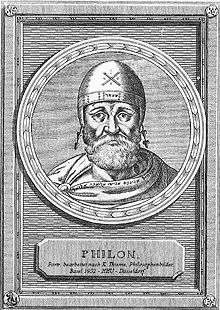
- Philo. Allegorical Interpretation 2:15:54–55; 3: 15:46, 31:95, 32:101, 48:140–42; That the Worse Is Wont To Attack the Better 44:159–60; On the Posterity of Cain and His Exile 4:13, 5:15–16, 41:136, 46:158, 48:169; On the Giants 5:2–3, 12:53–55; On the Unchangableness of God 24:109–10; Concerning Noah's Work as a Planter 6:26; On Drunkenness 15:66–67, 24:96; On the Migration of Abraham 2:7–8, 15:84–85, 31:170–71; Who Is the Heir of Divine Things? 4:19–20, 35:167–68, 38:186–39:189, 41:196; On Flight and Finding 17:88–90, 29:165; On the Change of Names 2:7–10, 17:108–09; On the Life of Moses 2:49:270–74; The Special Laws 3:22:124–27. Alexandria, Egypt, early 1st Century C.E.. Reprinted in, e.g., The Works of Philo: Complete and Unabridged, New Updated Edition. Translated by Charles Duke Yonge, pages 43, 55, 61, 66, 129, 133, 145, 148–49, 153, 156, 167, 193, 212, 215, 253, 261, 269, 277, 290–92, 329, 336, 341, 350, 515, 606. Peabody, Massachusetts: Hendrickson Publishers, 1993. ISBN 0-943575-93-1.
- Romans 9:14–18. 1st Century. ("I will have mercy on whom I have mercy").
- Mark 14:12–26 (Passover). Circa 70 C.E.
- Matthew 26:17–30 (Passover). Circa 70–100 C.E.
- Luke 22:14–20 (Passover). Circa 80–150 C.E.
- John 7:1–53 (Sukkot).
Classical rabbinic
- Mishnah: Sheviit 1:1–4; Challah 4:9; Shabbat 1:1–24:5; Pesachim 1:1–10:9; Shekalim 1:1–4:9; Yoma 3:10; Sukkah 1:1–5:8; Beitzah 1:1–5:7; Megillah 3:4, 4:10; Avot 5:6, 13–14; Zevachim 2:1, 9:7; Menachot 9:2; Chullin 8:4; Bekhorot 1:1–7; Temurah 7:4; Keritot 1:1–2. Land of Israel, circa 200 C.E. Reprinted in, e.g., The Mishnah: A New Translation. Translated by Jacob Neusner, pages 68–69, 157, 179–208, 229–58, 269, 279–99, 321, 324, 686–88, 721, 751, 781, 788–89, 835–37. New Haven: Yale University Press, 1988. ISBN 0-300-05022-4.
- Tosefta: Challah 2:9; Shabbat 1:1–17:29; Pisha (Pesachim) 1:1–10:13; Shekalim 1:1–3:1; Kippurim (Yoma) 1:18, 2:1, 4:9, 13–14; Sukkah 1:1–4:28; Yom Tov (Beitzah) 1:1–4:11; Megillah 3:1, 36; Sotah 3:10, 6:6, 11; Bava Kamma 7:4; Sanhedrin 4:9, 13:3; Avodah Zarah 3:19, 4:6; Menachot 1:12, 7:1; Parah 4:4. Land of Israel, circa 300 C.E. Reprinted in, e.g., The Tosefta: Translated from the Hebrew, with a New Introduction. Translated by Jacob Neusner, volume 1, pages 339, 357–427, 471–539, 546, 548, 564–604, 644, 652, 700–01, 841, 856, 860; volume 2, pages 986–87, 1160, 1182, 1189, 1273, 1276, 1409, 1433, 1754. Peabody, Massachusetts: Hendrickson Publishers, 2002. ISBN 1-56563-642-2.
- Mekhilta According to Rabbi Ishmael 81:1. Land of Israel, late 4th Century. Reprinted in, e.g., Mekhilta According to Rabbi Ishmael. Translated by Jacob Neusner, volume 2, pages 251–57. Atlanta: Scholars Press, 1988. ISBN 1-55540-237-2.
- Jerusalem Talmud: Peah 3a, 8a, 10a, 22b, 31b; Sheviit 1a, 4a; Bikkurim 1a, 23a; Shabbat 1a–113b; Pesachim 1a–86a; Shekalim 1a–; Yoma 21b, 23b, 30a, 49b, 55a, 57a; Sukkah 1a–33b; Beitzah 1a–49b; Rosh Hashanah 7b; Megillah 33b, 40a; Sanhedrin 30a. Land of Israel, circa 400 C.E. Reprinted in, e.g., Talmud Yerushalmi. Edited by Chaim Malinowitz, Yisroel Simcha Schorr, and Mordechai Marcus, volumes 3, 6a, 12–15, 18–19, 21–24, 26. Brooklyn: Mesorah Publications, 2006–2013.
.jpg)
- Babylonian Talmud: Berakhot 7a–b, 10b, 30b, 32a–b, 55a, 62b, 63b; Shabbat 10b, 30a, 33a, 69b–70a, 86a, 87a, 89a, 119b, 132a; Eruvin 22a, 54a, 96a; Pesachim 2a–121b; Shekalim 2a–22b; Yoma 3b, 22a, 28a, 32b, 36b–37a, 43b, 45a, 66b, 85b–86b; Sukkah 2a–56b; Beitzah 2a–40b; Rosh Hashanah 9a, 16b, 17b; Taanit 8a, 21b, 27b, 28b; Megillah 6b, 10b, 15a–b, 19b, 25a–b, 29b–30a, 31a; Moed Katan 3b–4a, 9a, 15a, 16b, 18b; Chagigah 6b, 11b, 12b, 16a; Yevamot 6b–7a, 49b, 62a, 72a; Ketubot 30a, 31a, 34a, 106a; Nedarim 10b, 32a, 33a, 38a; Nazir 47a; Sotah 13b–14a; Gittin 60b; Kiddushin 17a, 29a–b, 33b; Bava Kamma 34b, 50a, 55a, 71a, 92a, 112a, 119a; Bava Batra 10b, 15a–b, 75a; Sanhedrin 7a, 13a, 27b, 35b, 38b, 56b, 60b, 63a, 74a, 78b, 83b, 102a, 108a, 110a, 111a; Makkot 8b, 11a, 12a, 13a, 14b, 23a–24a; Shevuot 10b, 15a, 39a; Avodah Zarah 8a, 10b, 44a, 53b; Horayot 4a–b, 6b, 11b; Zevachim 15b, 18a, 19b, 21a, 112b; Menachot 5b–6a, 21b, 35b, 36b, 53b, 72a, 84b, 87b–88a, 89a, 99b, 101b; Chullin 62b, 106b, 114a, 115a, 139b; Bekhorot 3a, 6a, 50a, 51b; Arakhin 4a, 15b, 16b; Temurah 14b, 16a; Keritot 2a, 3a, 5a–6b; Meilah 19a; Niddah 40a, 41a. Babylonia, 6th Century. Reprinted in, e.g., Talmud Bavli. Edited by Yisroel Simcha Schorr, Chaim Malinowitz, and Mordechai Marcus, 72 volumes. Brooklyn: Mesorah Publications, 2006.
Medieval
- Exodus Rabbah 39:1–47:9. 10th Century. Reprinted in, e.g., Midrash Rabbah: Exodus. Translated by S. M. Lehrman, voloume 3, pages 458–545. London: Soncino Press, 1939. ISBN 0-900689-38-2.
- Solomon ibn Gabirol. A Crown for the King, 26:322–23. Spain, 11th Century. Translated by David R. Slavitt, pages 42–43. New York: Oxford University Press, 1998. ISBN 0-19-511962-2.
- Rashi. Commentary. Exodus 30–34. Troyes, France, late 11th Century. Reprinted in, e.g., Rashi. The Torah: With Rashi's Commentary Translated, Annotated, and Elucidated. Translated and annotated by Yisrael Isser Zvi Herczeg, volume 2, pages 423–86. Brooklyn: Mesorah Publications, 1994. ISBN 0-89906-027-7.
- Rashbam. Commentary on the Torah. Troyes, early 12th century. Reprinted in, e.g., Rashbam's Commentary on Exodus: An Annotated Translation. Edited and translated by Martin I. Lockshin, pages 384–424. Atlanta: Scholars Press, 1997. ISBN 0-7885-0225-5.
- Judah Halevi. Kuzari. 1:97; 2:2, 26, 80; 4:3, 15. Toledo, Spain, 1130–1140. Reprinted in, e.g., Jehuda Halevi. Kuzari: An Argument for the Faith of Israel. Introduction by Henry Slonimsky, pages 68–69, 83, 105, 132, 211, 221–22. New York: Schocken, 1964. ISBN 0-8052-0075-4.

- Abraham ibn Ezra. Commentary on the Torah. France, 1153. Reprinted in, e.g., Ibn Ezra's Commentary on the Pentateuch: Exodus (Shemot). Translated and annotated by H. Norman Strickman and Arthur M. Silver, volume 2, pages 628–729. New York: Menorah Publishing Company, 1996. ISBN 0-932232-08-6.
- Maimonides. Guide for the Perplexed, part 1, chapters 4, 8, 15, 16, 18, 21, 37, 46, 48, 54, 64, 66; part 2, chapters 32, 45, 47; part 3, chapters 17, 24, 32, 41, 45, 48, 49, 51, 53. Cairo, Egypt, 1190. Reprinted in, e.g., Moses Maimonides. The Guide for the Perplexed. Translated by Michael Friedländer, pages 3, 17, 21, 26–27, 30–31, 52–53, 61, 65, 75–76, 96, 98, 221, 245, 248, 287, 304, 323, 346, 358, 371, 380, 385, 392–93. New York: Dover Publications, 1956. ISBN 0-486-20351-4.
- Hezekiah ben Manoah. Hizkuni. France, circa 1240. Reprinted in, e.g., Chizkiyahu ben Manoach. Chizkuni: Torah Commentary. Translated and annotated by Eliyahu Munk, volume 3, pages 611–44. Jerusalem: Ktav Publishers, 2013. ISBN 978-1-60280-261-2.

- Nachmanides. Commentary on the Torah. Jerusalem, circa 1270. Reprinted in, e.g., Ramban (Nachmanides): Commentary on the Torah. Translated by Charles B. Chavel, volume 2, pages 510–94. New York: Shilo Publishing House, 1973. ISBN 0-88328-007-8.
- Zohar, part 2, pages 187b–193b. Spain, late 13th Century. Reprinted in, e.g., The Zohar. Translated by Harry Sperling and Maurice Simon. 5 volumes. London: Soncino Press, 1934.
- Bahya ben Asher. Commentary on the Torah. Spain, early 14th century. Reprinted in, e.g., Midrash Rabbeinu Bachya: Torah Commentary by Rabbi Bachya ben Asher. Translated and annotated by Eliyahu Munk, volume 4, pages 1311–417. Jerusalem: Lambda Publishers, 2003. ISBN 965-7108-45-4.
- Jacob ben Asher (Baal Ha-Turim). Commentary on the Torah. Early 14th century. Reprinted in, e.g., Baal Haturim Chumash: Shemos/Exodus. Translated by Eliyahu Touger; edited and annotated by Avie Gold, volume 2, pages 881–927. Brooklyn: Mesorah Publications, 2000. ISBN 1-57819-129-7.
- Isaac ben Moses Arama. Akedat Yizhak (The Binding of Isaac). Late 15th century. Reprinted in, e.g., Yitzchak Arama. Akeydat Yitzchak: Commentary of Rabbi Yitzchak Arama on the Torah. Translated and condensed by Eliyahu Munk, volume 1, pages 483–519. New York, Lambda Publishers, 2001. ISBN 965-7108-30-6.
Modern
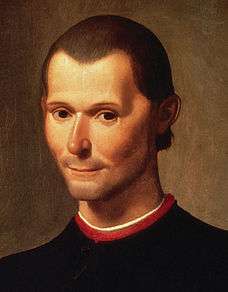
- Abraham Saba. Ẓeror ha-Mor (Bundle of Myrrh). Fez, Morocco, circa 1500. Reprinted in, e.g., Tzror Hamor: Torah Commentary by Rabbi Avraham Sabba. Translated and annotated by Eliyahu Munk, volume 3, pages 1147–220. Jerusalem, Lambda Publishers, 2008. ISBN 978-965-524-013-9.
- Niccolò Machiavelli. The Prince, chapter 6. Florence, Italy, 1532.
- Obadiah ben Jacob Sforno. Commentary on the Torah. Venice, 1567. Reprinted in, e.g., Sforno: Commentary on the Torah. Translation and explanatory notes by Raphael Pelcovitz, pages 444–73. Brooklyn: Mesorah Publications, 1997. ISBN 0-89906-268-7.
- Moshe Alshich. Commentary on the Torah. Safed, circa 1593. Reprinted in, e.g., Moshe Alshich. Midrash of Rabbi Moshe Alshich on the Torah. Translated and annotated by Eliyahu Munk, volume 2, pages 563–606. New York, Lambda Publishers, 2000. ISBN 965-7108-13-6.
- Shlomo Ephraim Luntschitz. Kli Yakar. Lublin, 1602. Reprinted in, e.g., Kli Yakar: Shemos. Translated by Elihu Levine, volume 2, pages 273–344. Southfield, Michigan: Targum Press/Feldheim Publishers, 2007. ISBN 1-56871-422-X.
- Avraham Yehoshua Heschel. Commentaries on the Torah. Cracow, Poland, mid 17th century. Compiled as Chanukat HaTorah. Edited by Chanoch Henoch Erzohn. Piotrkow, Poland, 1900. Reprinted in Avraham Yehoshua Heschel. Chanukas HaTorah: Mystical Insights of Rav Avraham Yehoshua Heschel on Chumash. Translated by Avraham Peretz Friedman, pages 191–98. Southfield, Michigan: Targum Press/Feldheim Publishers, 2004. ISBN 1-56871-303-7.
.jpg)
- Thomas Hobbes. Leviathan, 1:12; 3:34, 36, 40; 4:45; Review & Conclusion. England, 1651. Reprint edited by C. B. Macpherson, pages 181, 431, 437–38, 460–61, 503–04, 672, 676–77, 723. Harmondsworth, England: Penguin Classics, 1982. ISBN 0-14-043195-0.
- Chaim ibn Attar. Ohr ha-Chaim. Venice, 1742. Reprinted in Chayim ben Attar. Or Hachayim: Commentary on the Torah. Translated by Eliyahu Munk, volume 2, pages 814–93. Brooklyn: Lambda Publishers, 1999. ISBN 965-7108-12-8.
- Yaakov Culi and Yitzchak Magriso. Me'am Lo'ez. Constantinople, 1746. Reprinted in Jacob Culi and Yitzchak Magriso. The Torah Anthology: Me'am Lo'ez. Translated by Aryeh Kaplan, volume 9, pages 267–355. Jerusalem: Moznaim Publishing, 1990. ISBN 0-940118-09-2. And Yitzchak Magriso. The Torah Anthology: Me'am Lo'ez. Translated by Aryeh Kaplan, volume 10, pages 3–174. Jerusalem: Moznaim Publishing, 1991. ISBN 0-940118-00-9.
- Moses Mendelssohn. Jerusalem, § 2. Berlin, 1783. Reprinted in Jerusalem: Or on Religious Power and Judaism. Translated by Allan Arkush; introduction and commentary by Alexander Altmann, pages 120, 122–23, 129. Hanover, N.H.: Brandeis University Press, 1983. ISBN 0-87451-264-6.

- Nachman of Breslov. Teachings. Bratslav, Ukraine, before 1811. Reprinted in Rebbe Nachman's Torah: Breslov Insights into the Weekly Torah Reading: Exodus-Leviticus. Compiled by Chaim Kramer; edited by Y. Hall, pages 232–81. Jerusalem: Breslov Research Institute, 2011. ISBN 978-1-928822-53-0.
- Henry Wadsworth Longfellow The Jewish Cemetery at Newport. Boston, 1854. Reprinted in Harold Bloom. American Religious Poems, pages 80–81. New York: Library of America, 2006. ISBN 978-1-931082-74-7.
- Shlomo Ganzfried. Kitzur Shulchon Oruch, ch. 140. Hungary, 1864. Translated by Eliyahu Touger, volume 2, page 587. New York: Moznaim Publishing, 1991. ISBN 0-940118-63-7.

- Samson Raphael Hirsch. The Pentateuch: Exodus. Translated by Isaac Levy, volume 2, pages 576–664. Gateshead: Judaica Press, 2nd edition 1999. ISBN 0-910818-12-6. Originally published as Der Pentateuch uebersetzt und erklaert. Frankfurt, 1867–1878.
- Samuel David Luzzatto (Shadal). Commentary on the Torah. Padua, 1871. Reprinted in, e.g., Samuel David Luzzatto. Torah Commentary. Translated and annotated by Eliyahu Munk, volume 3, pages 867–93. New York: Lambda Publishers, 2012. ISBN 978-965-524-067-2.
.jpg)
- Emily Dickinson. Poem 1247 (To pile like Thunder to its close). Circa 1873. Poem 1260 (Because that you are going). Circa 1873. Poem 1719 (God is indeed a jealous God —). 19th Century. Poem 1733 (No man saw awe, nor to his house). 19th Century. In The Complete Poems of Emily Dickinson. Edited by Thomas H. Johnson, pages 547, 551–52, 698, 703. New York: Little, Brown & Co., 1960. ISBN 0-316-18414-4.
- Samson Raphael Hirsch. The Jewish Sabbath. Frankfurt, before 1889. Translated by Ben Josephussoro. 1911. Reprinted Lexington, Kentucky: CreateSpace Independent Publishing Platform, 2014. ISBN 978-1492373438.
- Yehudah Aryeh Leib Alter. Sefat Emet. Góra Kalwaria (Ger), Poland, before 1906. Excerpted in The Language of Truth: The Torah Commentary of Sefat Emet. Translated and interpreted by Arthur Green, pages 129–34. Philadelphia: Jewish Publication Society, 1998. ISBN 0-8276-0650-8. Reprinted 2012. ISBN 0-8276-0946-9.
- Louis Ginzberg. Legends of the Jews, 3:119–44. Philadelphia: Jewish Publication Society, 1911.
- Abraham Isaac Kook. The Moral Principles. The Lights of Holiness. Early 20th Century. Reprinted in Abraham Isaac Kook: the Lights of Penitence, the Moral Principles, Lights of Holiness, Essays, Letters, and Poems. Translated by Ben Zion Bokser, pages 148, 207. Mahwah, New Jersey: Paulist Press 1978. ISBN 0-8091-2159-X.
- Benno Jacob. The Second Book of the Bible: Exodus. London, 1940. Translated by Walter Jacob, pages 828–1007. Hoboken, New Jersey: KTAV Publishing House, 1992. ISBN 0-88125-028-7.
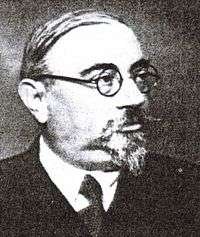
- Umberto Cassuto. A Commentary on the Book of Exodus. Jerusalem, 1951. Translated by Israel Abrahams, pages 392–451. Jerusalem: The Magnes Press, The Hebrew University, 1967.
- Morris Adler. The World of the Talmud, pages 28–29, 50–51, 91–92. B'nai B'rith Hillel Foundations, 1958. Reprinted Kessinger Publishing, 2007. ISBN 0-548-08000-3.
- Robert C. Dentan, "The Literary Affinities of Exodus Xxxiv 6f." Vetus Testamentum, volume 13 (1963): pages 34–51.
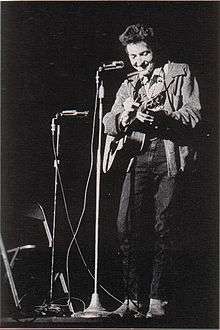
- Bob Dylan. Gates of Eden. Columbia Records, 1965. (Golden Calf).
- James Muilenburg. "The Intercession of the Covenant Mediator (Exodus 33:1a,12–17)." In Words and Meanings: Essays Presented to David Winton Thomas. Edited by Peter R. Ackroyd and Barnabas Lindars, pages 159–81. Cambridge: University Press, 1968. ISBN 0-521-07270-0.
- Phyllis Trible. God and the Rhetoric of Sexuality, pages 31–59. Philadelphia: Fortress Press, 1978. ISBN 0-8006-0464-4. (God's feminine merciful quality, or rachum).
- Elie Munk. The Call of the Torah: An Anthology of Interpretation and Commentary on the Five Books of Moses. Translated by E.S. Mazer, volume 2, pages 426–503. Brooklyn: Mesorah Publications, 1995. ISBN 0-89906-042-0. Originally published as La Voix de la Thora. Paris: Fondation Samuel et Odette Levy, 1981.
- Herbert C. Brichto. "The Worship of the Golden Calf: A Literary Analysis of a Fable on Idolatry." Hebrew Union College Annual, volume 54 (1983): pages 1–44.
- Jacob Milgrom. "‘You Shall Not Boil a Kid in Its Mother's Milk': An archaeological myth destroyed." Bible Review, volume 1 (number 3) (Fall 1985): pages 48–55.
- Harvey J. Fields. A Torah Commentary for Our Times: Volume II: Exodus and Leviticus, pages 77–85. New York: UAHC Press, 1991. ISBN 0-8074-0334-2.
- Nahum M. Sarna. The JPS Torah Commentary: Exodus: The Traditional Hebrew Text with the New JPS Translation, pages 195–222. Philadelphia: Jewish Publication Society, 1991. ISBN 0-8276-0327-4.
- Lawrence Kushner. God Was in This Place and I, I Did Not Know: Finding Self, Spirituality and Ultimate Meaning, pages 31–32, 41. Jewish Lights Publishing, 1993. ISBN 1-879045-33-8. (the Place; the Golden Calf).
- Nehama Leibowitz. New Studies in Shemot (Exodus), volume 2, pages 535–643. Jerusalem: Haomanim Press, 1993. Reprinted as New Studies in the Weekly Parasha. Lambda Publishers, 2010. ISBN 965-524-038-X.
- Aaron Wildavsky. Assimilation versus Separation: Joseph the Administrator and the Politics of Religion in Biblical Israel, pages 3–4. New Brunswick, New Jersey: Transaction Publishers, 1993. ISBN 1-56000-081-3.
- Walter Brueggemann. “The Book of Exodus.” In The New Interpreter's Bible. Edited by Leander E. Keck, volume 1, pages 917–56. Nashville: Abingdon Press, 1994. ISBN 0-687-27814-7.
- Judith S. Antonelli. "The Golden Calf." In In the Image of God: A Feminist Commentary on the Torah, pages 213–20. Northvale, New Jersey: Jason Aronson, 1995. ISBN 1-56821-438-3.
- Ellen Frankel. The Five Books of Miriam: A Woman’s Commentary on the Torah, pages _–_. New York: G. P. Putnam's Sons, 1996. ISBN 0-399-14195-2.
- Marc Gellman. "Gluing the Broken Commandments Back Together." In God's Mailbox: More Stories About Stories in the Bible, pages 68–72. New York: Morrow Junior Books, 1996. ISBN 0-688-13169-7.
- Sorel Goldberg Loeb and Barbara Binder Kadden. Teaching Torah: A Treasury of Insights and Activities, pages 140–47. Denver: A.R.E. Publishing, 1997. ISBN 0-86705-041-1.
- Baruch J. Schwartz. "What Really Happened at Mount Sinai? Four biblical answers to one question." Bible Review, volume 13 (number 5) (October 1997).
- Mary Doria Russell. Children of God: A Novel, page 428. New York: Villard, 1998. ISBN 0-679-45635-X. (seeing only God's back).
- Ellen Lippmann. "The Women Didn't Build the Golden Calf — or Did They?" In The Women's Torah Commentary: New Insights from Women Rabbis on the 54 Weekly Torah Portions. Edited by Elyse Goldstein, pages 164–71. Woodstock, Vermont: Jewish Lights Publishing, 2000. ISBN 1-58023-076-8.
- Exodus to Deuteronomy: A Feminist Companion to the Bible (Second Series). Edited by Athalya Brenner, pages 136–41. Sheffield: Sheffield Academic Press, 2000. ISBN 1-84127-079-2.
- Lainie Blum Cogan and Judy Weiss. Teaching Haftarah: Background, Insights, and Strategies, pages 164–72. Denver: A.R.E. Publishing, 2002. ISBN 0-86705-054-3.
- Menachem Davis. The Schottenstein Edition Siddur for the Sabbath and Festivals with an Interlinear Translation, XXVII. Brooklyn: Mesorah Publications, 2002. ISBN 1-57819-697-3. (Sabbath as a source of holiness).
- Katharine Doob Sakenfeld. The Meaning of Hesed in the Hebrew Bible: A New Inquiry. Wipf & Stock Publishers, 2002. ISBN 1-57910-927-6.
- Rodger Kamenetz. "The Broken Tablets." In The Lowercase Jew, page 40. Evanston, Illinois: Triquarterly Books, 2003. ISBN 0-8101-5152-9.
- Alan Lew. This Is Real and You Are Completely Unprepared: The Days of Awe as a Journey of Transformation, pages 53–55, 136. Boston: Little, Brown and Co., 2003. ISBN 0-316-73908-1.
- Jack M. Sasson. "Should Cheeseburgers Be Kosher? A Different Interpretation of Five Hebrew Words." Bible Review, volume 19 (numbers 6) (December 2003): pages 40–43, 50–51.

- Jeffrey H. Tigay. "Exodus." In The Jewish Study Bible. Edited by Adele Berlin and Marc Zvi Brettler, pages 179–91. New York: Oxford University Press, 2004. ISBN 0-19-529751-2.
- W. Gunther Plaut. The Torah: A Modern Commentary: Revised Edition. Revised edition edited by David E.S. Stern, pages 581–610. New York: Union for Reform Judaism, 2006. ISBN 0-8074-0883-2.
- William H.C. Propp. Exodus 19–40, volume 2A, pages 317–19, 358–71, 534–623. New York: Anchor Bible, 2006. ISBN 0-385-24693-5.
- Suzanne A. Brody. "Bloody Water." In Dancing in the White Spaces: The Yearly Torah Cycle and More Poems, page 83. Shelbyville, Kentucky: Wasteland Press, 2007. ISBN 1-60047-112-9.
- Esther Jungreis. Life Is a Test, pages 86, 98–99, 144–46, 208–09. Brooklyn: Shaar Press, 2007. ISBN 1-4226-0609-0.

- Gloria London. "Why Milk and Meat Don't Mix: A New Explanation for a Puzzling Kosher Law." Biblical Archaeology Review, volume 34 (number 6) (November/December 2008): pages 66–69.
- The Torah: A Women's Commentary. Edited by Tamara Cohn Eskenazi and Andrea L. Weiss, pages 495–520. New York: URJ Press, 2008. ISBN 0-8074-1081-0.
- Jonathan Goldstein. "The Golden Calf." In Ladies and Gentlemen, the Bible! pages 115–28. New York: Riverhead Books, 2009. ISBN 978-1-59448-367-7.

- Julie Cadwallader-Staub. Joy. In Face to Face: A Poetry Collection. DreamSeeker Books, 2010. ISBN 1-931038-52-X. ("land of milk and honey").
- Jonathan Sacks. Covenant & Conversation: A Weekly Reading of the Jewish Bible: Exodus: The Book of Redemption, pages 249–76. Jerusalem: Maggid Books, 2010. ISBN 1-59264-021-4.
- Joe Lieberman and David Klinghoffer. The Gift of Rest: Rediscovering the Beauty of the Sabbath. New York: Howard Books, 2011. ISBN 1-4516-0617-6.
- James W. Watts. “Aaron and the Golden Calf in the Rhetoric of the Pentateuch.” Journal of Biblical Literature, volume 130 (number 3) (fall 2011): pages 417–30.

- Shmuel Herzfeld. "Growing Our Congregation: The Numbers Game." In Fifty-Four Pick Up: Fifteen-Minute Inspirational Torah Lessons, pages 123–27. Jerusalem: Gefen Publishing House, 2012. ISBN 978-965-229-558-3.
- Daniel S. Nevins. “The Use of Electrical and Electronic Devices on Shabbat.” New York: Rabbinical Assembly, 2012.
- Torah MiEtzion: New Readings in Tanach: Shemot. Edited by Ezra Bick and Yaakov Beasley, pages 411–77. Jerusalem: Maggid Books, 2012. ISBN 1-61329-007-1.
- Adam Kirsch. "Ancient Laws for Modern Times: When is a tent just a tent and not like a bed or a hat? To update Jewish laws, the rabbis reasoned by analogy." Tablet Magazine. (February 26, 2013). (Shabbat).
- Adam Kirsch. "Leave the Jewish People Alone: Rabbis left enforcement of their Talmudic decrees to communal standards and voluntary commitment." Tablet Magazine. (March 5, 2013). (Shabbat).
- Adam Kirsch. "Written in the Stars (Or Not): To overcome fated lives, the Talmud's rabbis argued, perform virtuous acts according to Torah." Tablet Magazine. (March 12, 2013). (Shabbat).
- Adam Kirsch. "Navigating the Talmud's Alleys: The range of problems and the variety of answers in the study of Oral Law lead to new pathways of reasoning." Tablet Magazine. (March 18, 2013). (Shabbat).
- Amiel Ungar. "Tel Aviv and the Sabbath." The Jerusalem Report, volume 24 (number 8) (July 29, 2013): page 37.
- Martin Sieff. "The spirit of Elijah: Great leaders have replicated his courage against all odds." The Jerusalem Report, volume 24 (number 23) (February 24, 2014): page 48.
- Ester Bloom. "The Crazy New App for Using Your iPhone on Shabbos." Jewniverse. (October 1, 2014).
- “The Crazy New Invention for Using Electricity on Shabbat.” Jewniverse. (April 21, 2015).
External links
